Karin Taylor is a talented artist and iPhone photographer who takes amazing close-up macro photos of insects, flowers, leaves, and other tiny objects. Her exquisite jewel-like images show color and detail that you would never be able to see with the naked eye. You may already be familiar with Karin’s work as her photos are often featured in in our weekly photography contest. In this interview you’ll learn more about Karin and how she takes such beautiful close-up photos with her iPhone.

Tell us a little bit about yourself.
I live in the idyllic setting of a beautiful little seaside village on the east coast of Australia, with my husband Scott the Scientist and a Collie Rough called Nudge.
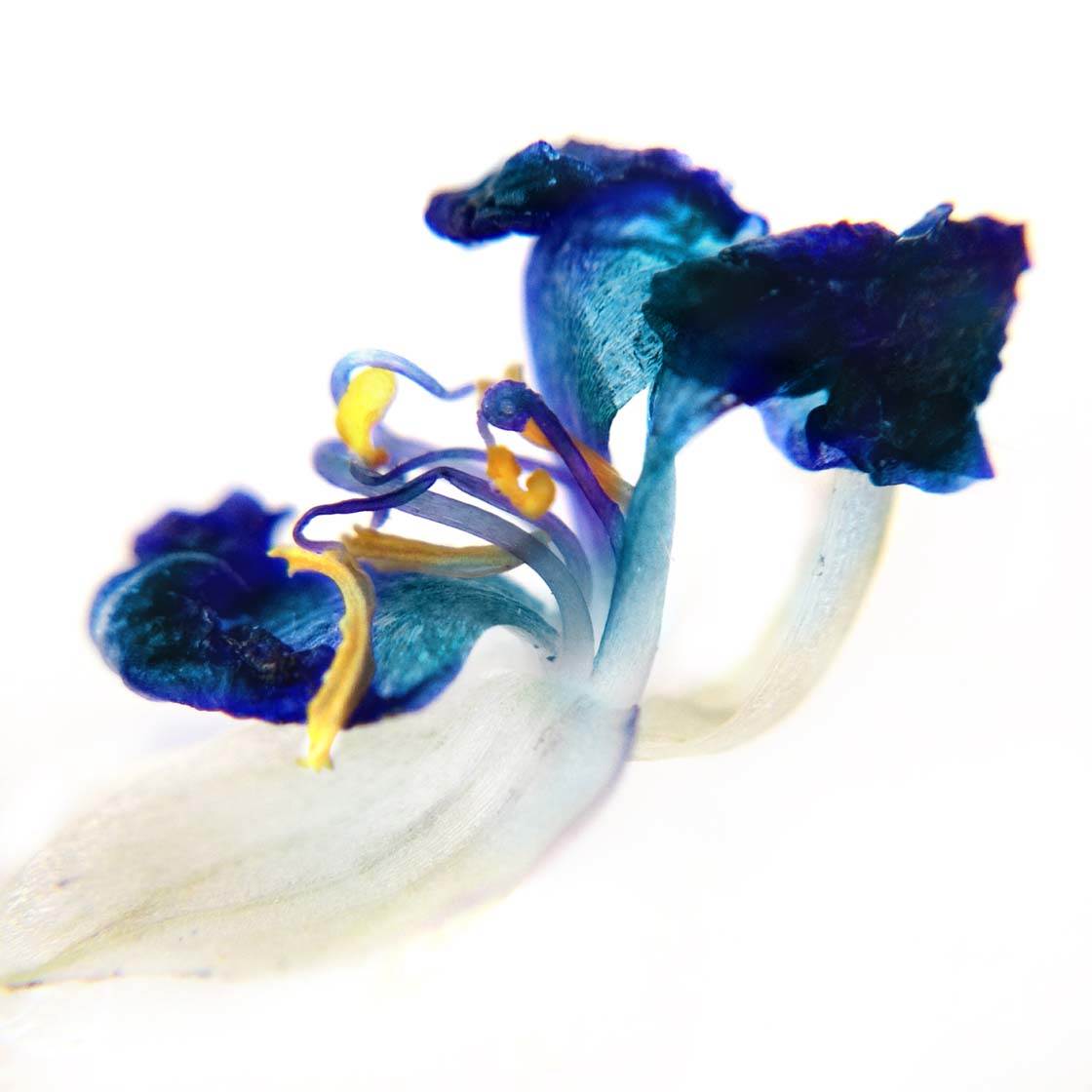
I’m a self-taught visual artist (drawing and painting), I love writing poetry and short stories, and have become an avid macro iPhone photographer over the last couple of years.
How did your iPhone photography journey begin?
It must be one of those things that happened rather organically, as I have no memory of taking my first iPhone photo or setting out to become an iPhone photographer. My background probably has a lot to do with it.
My father loved the natural world and passed that on to me. From an early age, I loved to observe nature and, when I was 5 years old I was given an old Box Brownie camera which I treasured. Looking through the viewfinder made me feel as though I’d entered a whole other world.
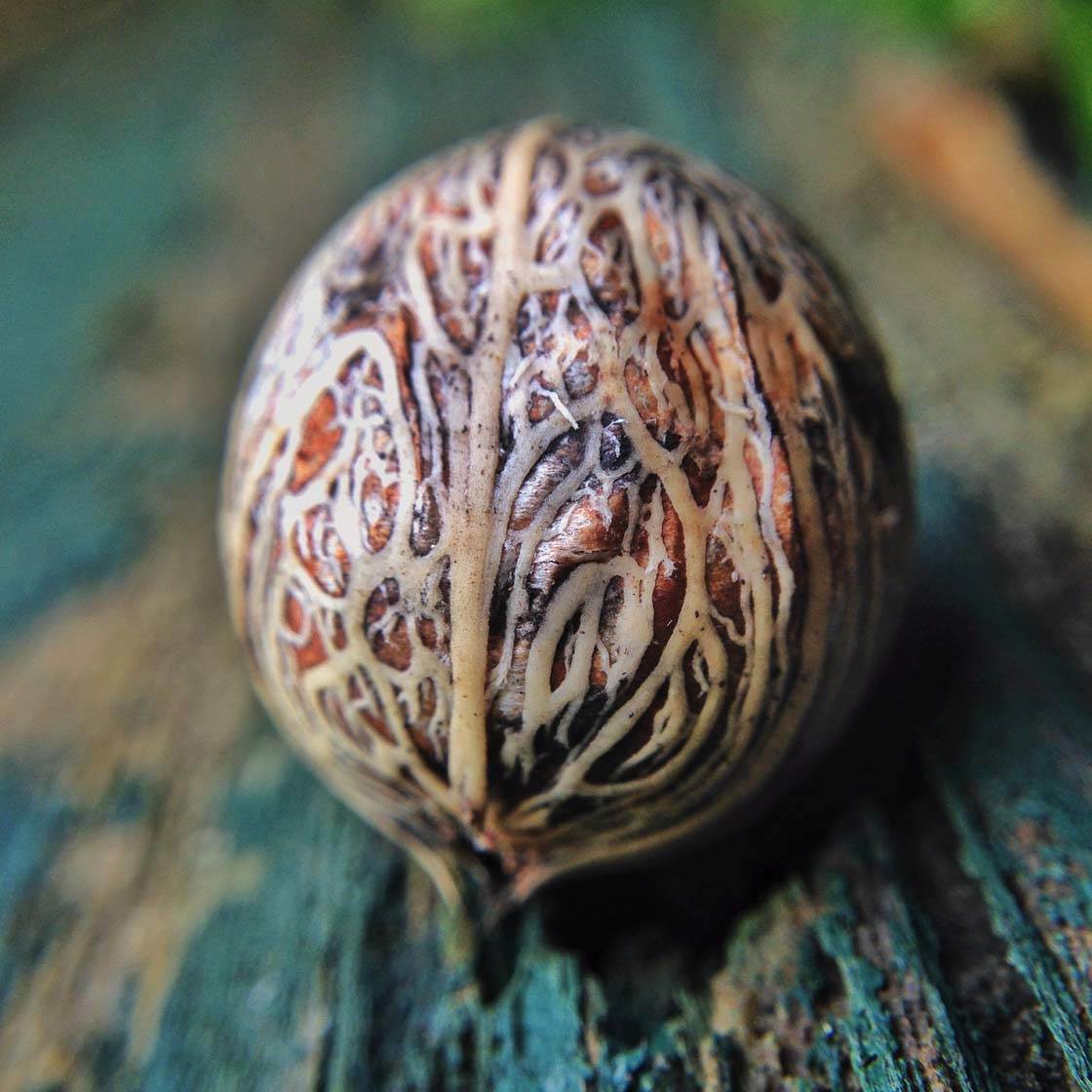
In my work as an visual artist, I had to learn to take really good photos of my work for print production. I used a Canon G11 Powershot, but I began to experiment more with the iPhone camera too. From there I could upload photos of my pencil drawings to my iPad, so I could paint them in an app called Procreate.
I hadn’t really considered using the iPhone for taking any other kinds of images, until a couple of years ago. After my children had grown up, I had more time to engage in beachcombing and going for nature walks.
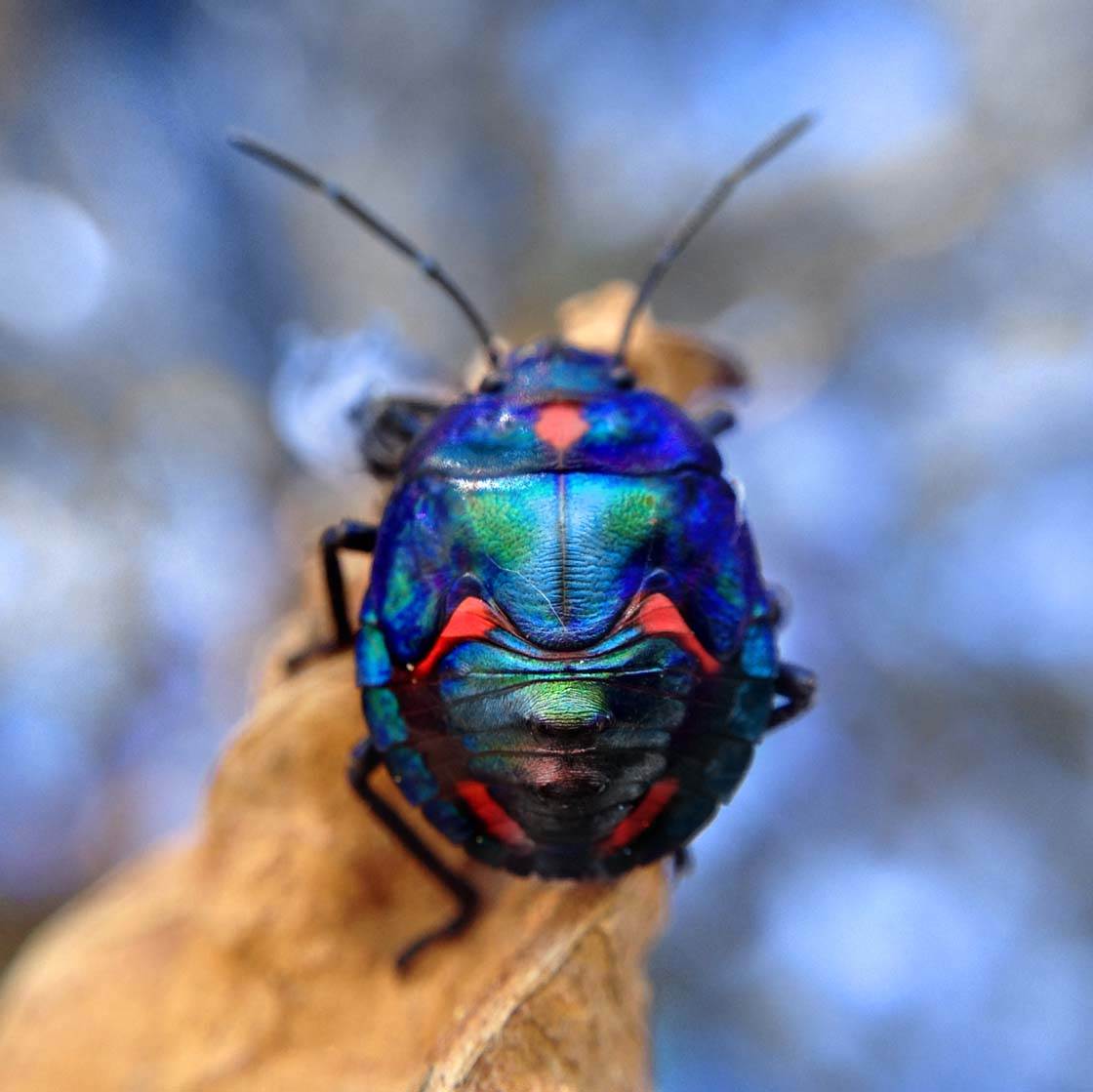
I started noticing small shells with brilliant colors, interesting sand sculptures created by crabs, as well as sand formations created by outgoing tides. I wanted to document and share these with my family, so naturally, because the iPhone was so convenient and always with me, I began to use it for that purpose.
What inspires you to take photos with the iPhone?
In a nutshell, it’s the wonder of nature that inspires me. It gives me such a sense of joy and wholesomeness.
The iPhone actually started out as a microscope for me. Long before I had my macro lens, I was using the iPhone to see things magnified, by zooming in to examine the details of a creature, a shell, peeling paint, etc.
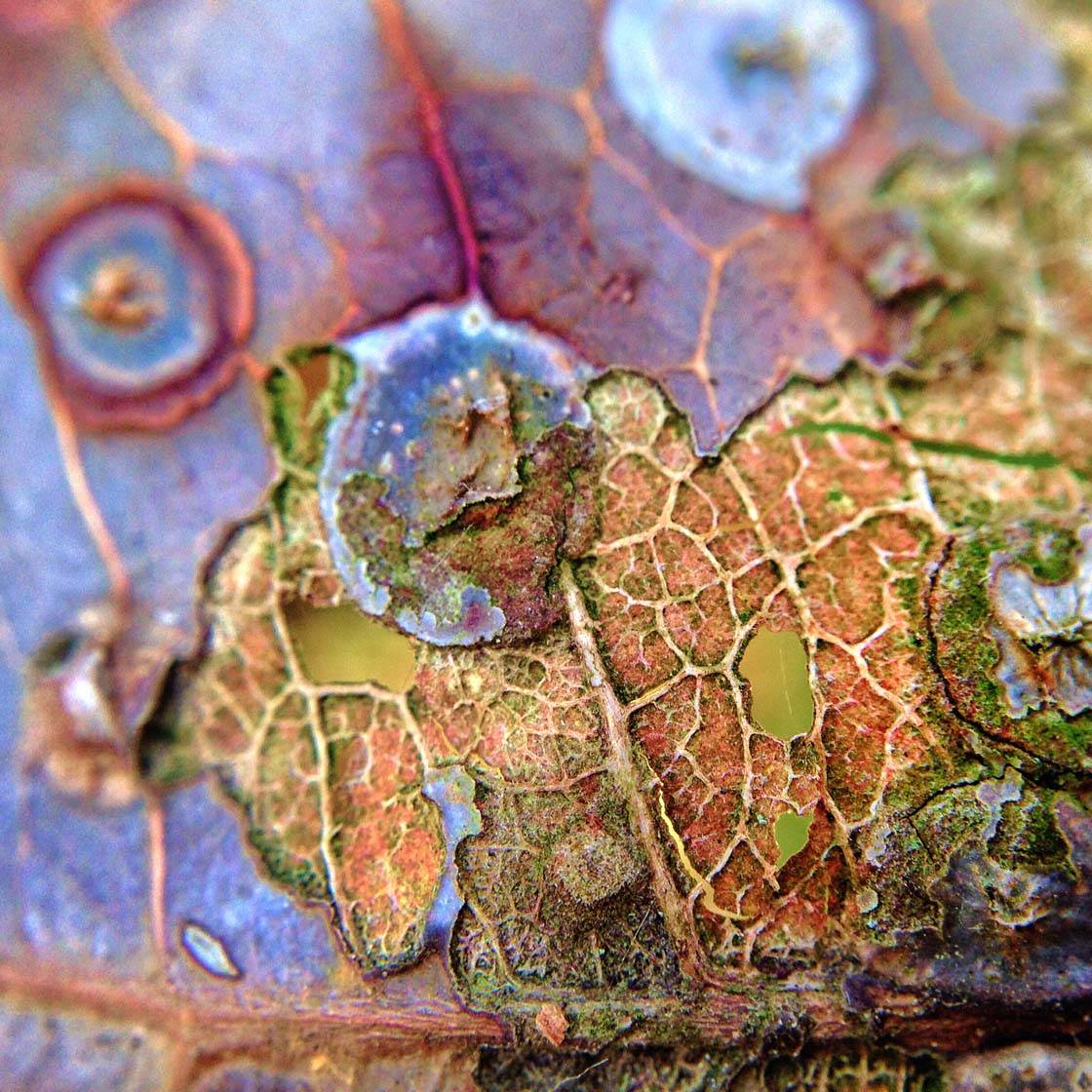
I love to photograph unusual things I see with my macro lens and share these images, because it gives me such a buzz. I love the feedback and different reactions I get, particularly when I share photos of jumping spiders!
Some people are horrified and other people get a whole new appreciation for the natural world around them. One person even mentioned they would think twice before they killed a jumping spider next time, because they’d seen how cute they are up close now. I think that’s a wonderful thing.
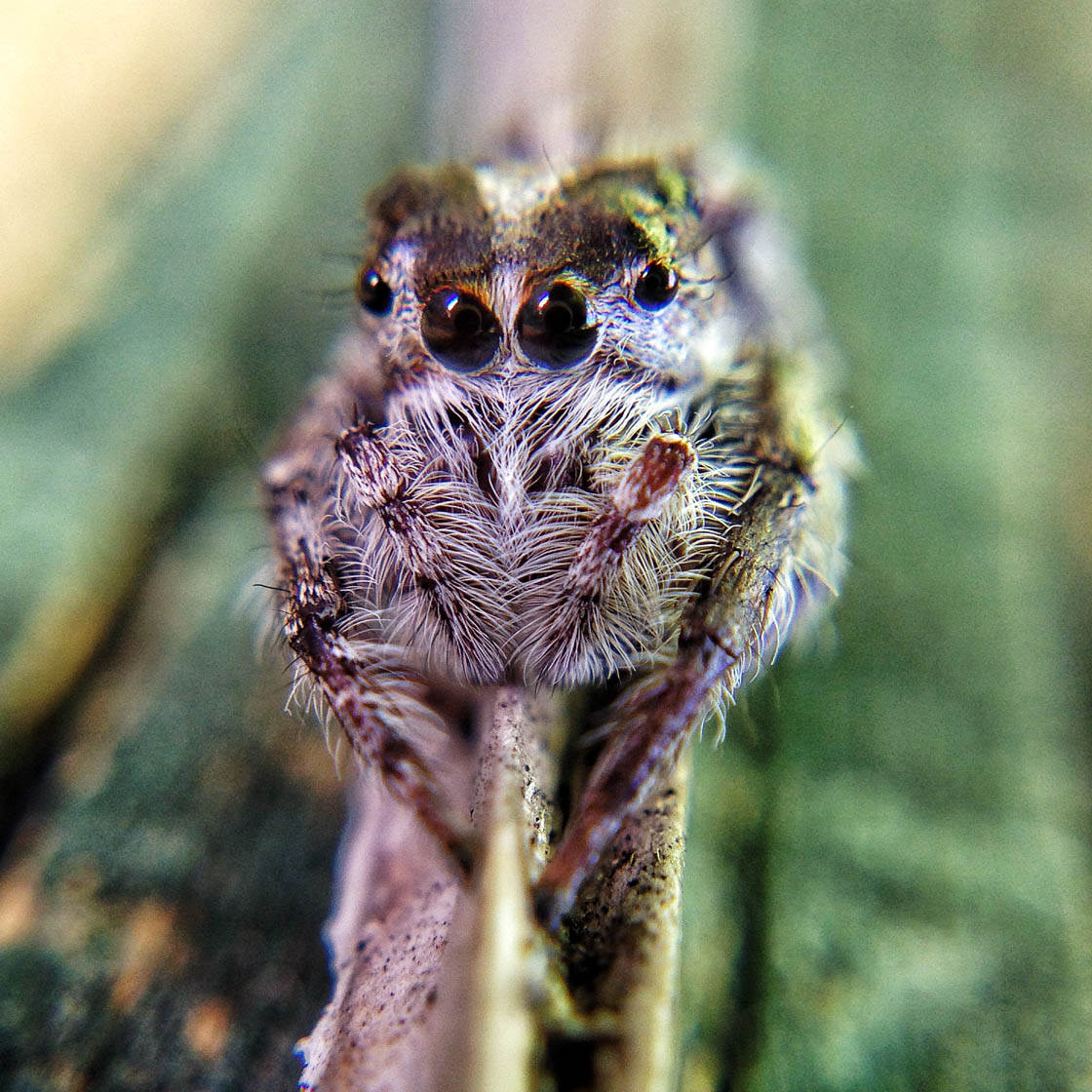
I love that my macro photography can give people a new appreciation of nature and the small things that go unnoticed all around us. It makes me feel great that I’m accomplishing some small yet significant thing.
Most of your iPhone photos are incredible close-up shots of flowers and insects. What draws you to macro photography over other genres?
Thank you very much! It probably stems back to when I was a child. My father and grandfather both instilled in me the importance of observing the natural world. They took me on walks where we spent time becoming aware of other worlds, habitats and little eco-systems around us.
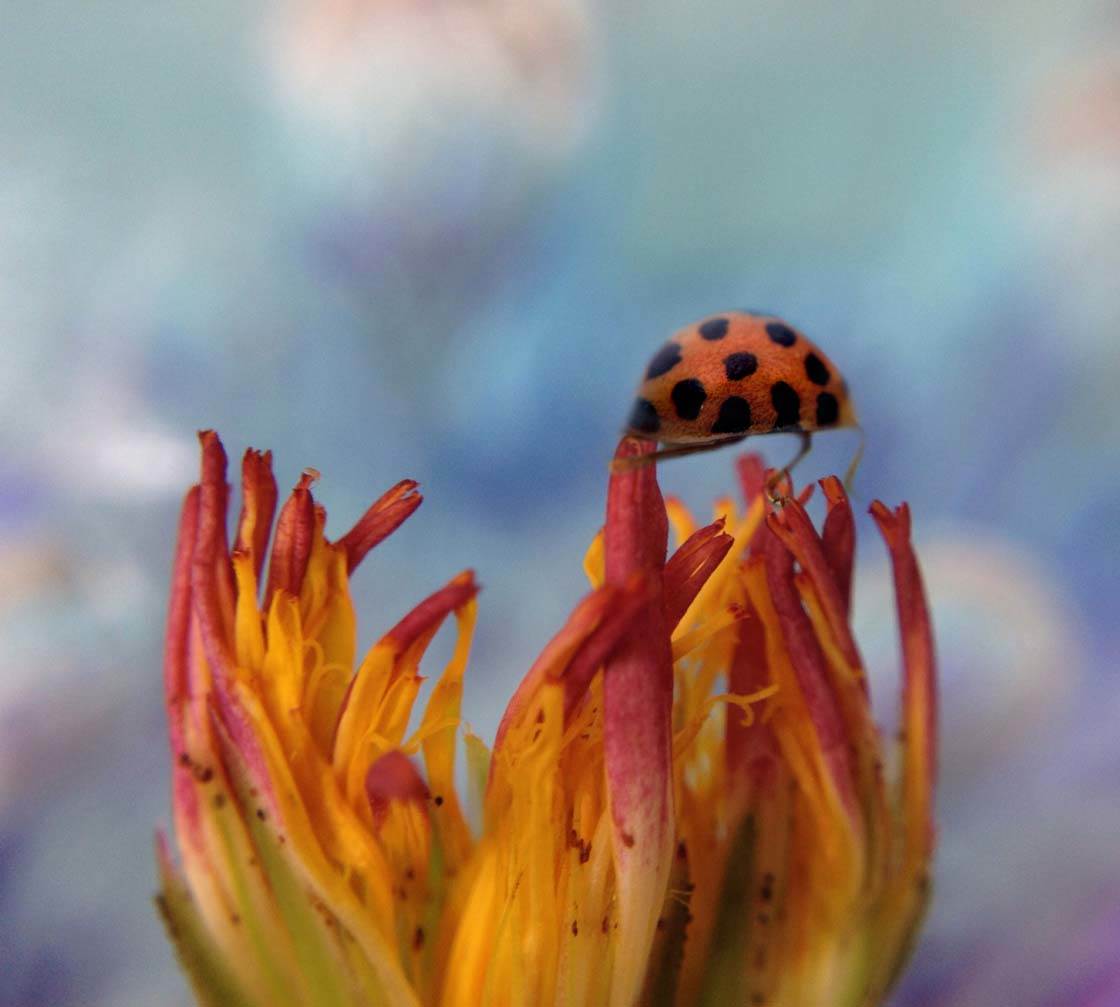
I recall the day Poppa took me to the park across the road to show me the trees there were covered in hundreds of cicada shells. I was overwhelmed and filled with a sense of wonder.
He taught me how you should always leave an area just as you found it, replacing the rock in exactly the same way if you disturbed it, so as to not upset the creatures living or sheltering there. I loved these little adventures.
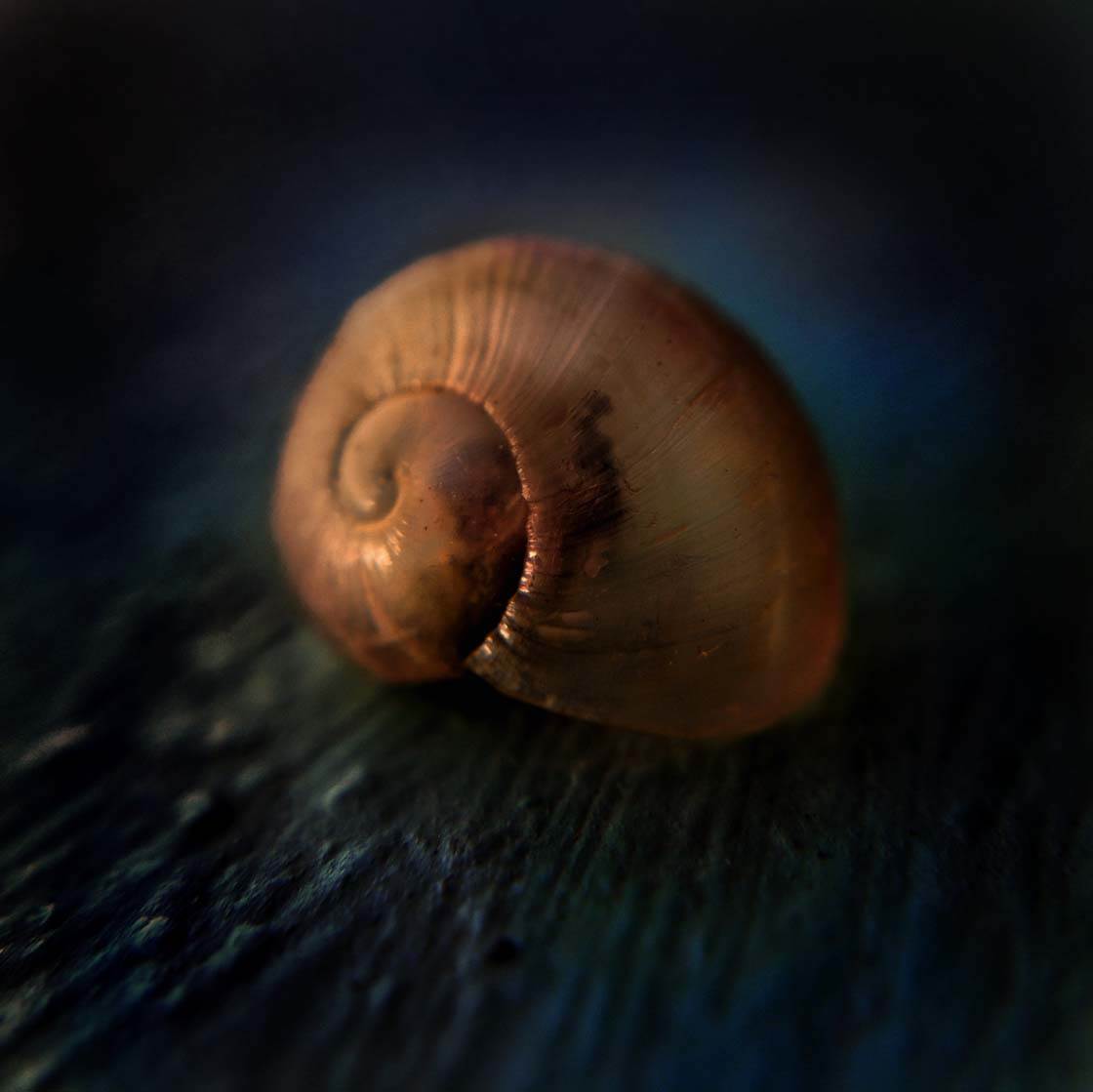
I was taught to look consciously, very hard and deliberately for unusual details and to spot things that might look different from the ordinary. I think this is where I get my love of macro photography from. This determination inside to see the details and share that with other interested people.
The iPhone, in combination with my macro lens, does a fantastic job of this for me, working as a little microscope to reveal tiny details that I never thought possible to see.
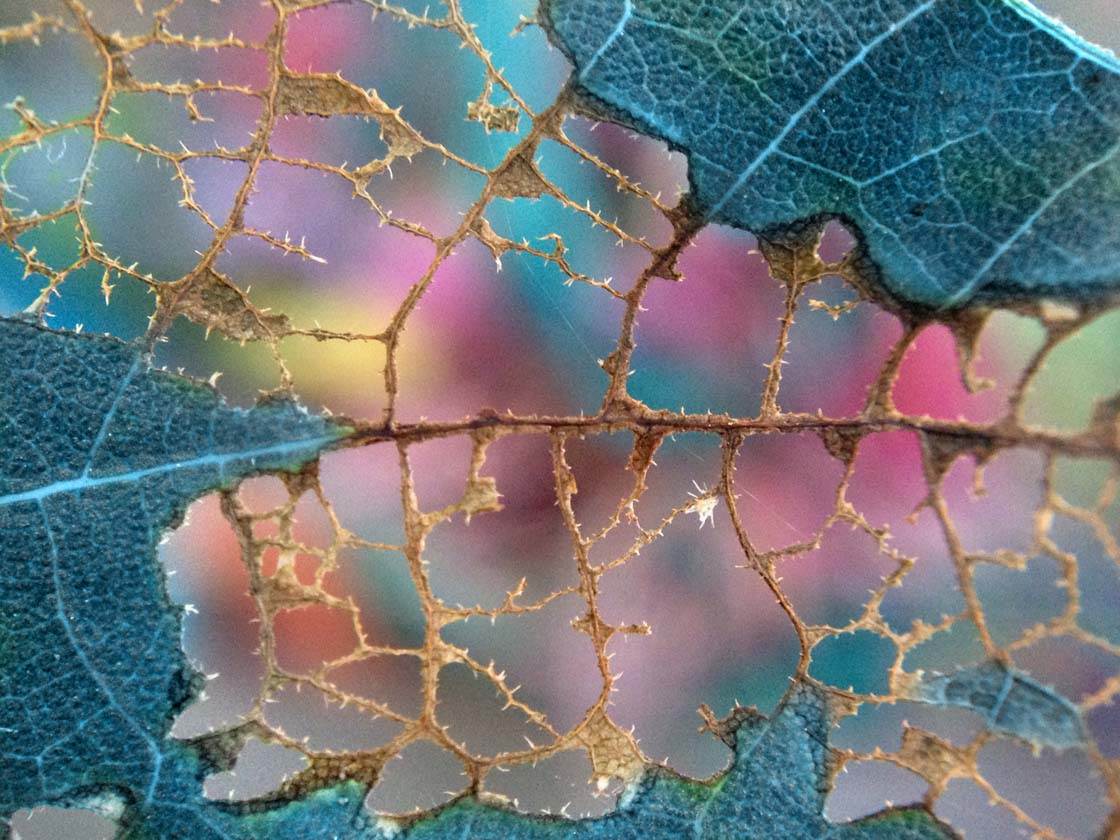
Where do you find such amazing subjects to photograph? And how do you manage to photograph those tiny, fast-moving bugs?!
Well, the truth is, you don’t have to go far from home when you’re a macro photographer. In fact, a lot of the time you find things just outside in your own garden, and sometimes even inside your house.
Having said that, I do venture a little further afield too at times. I like to go to the beach, the freshwater lake or on walks around and beyond my neighborhood.
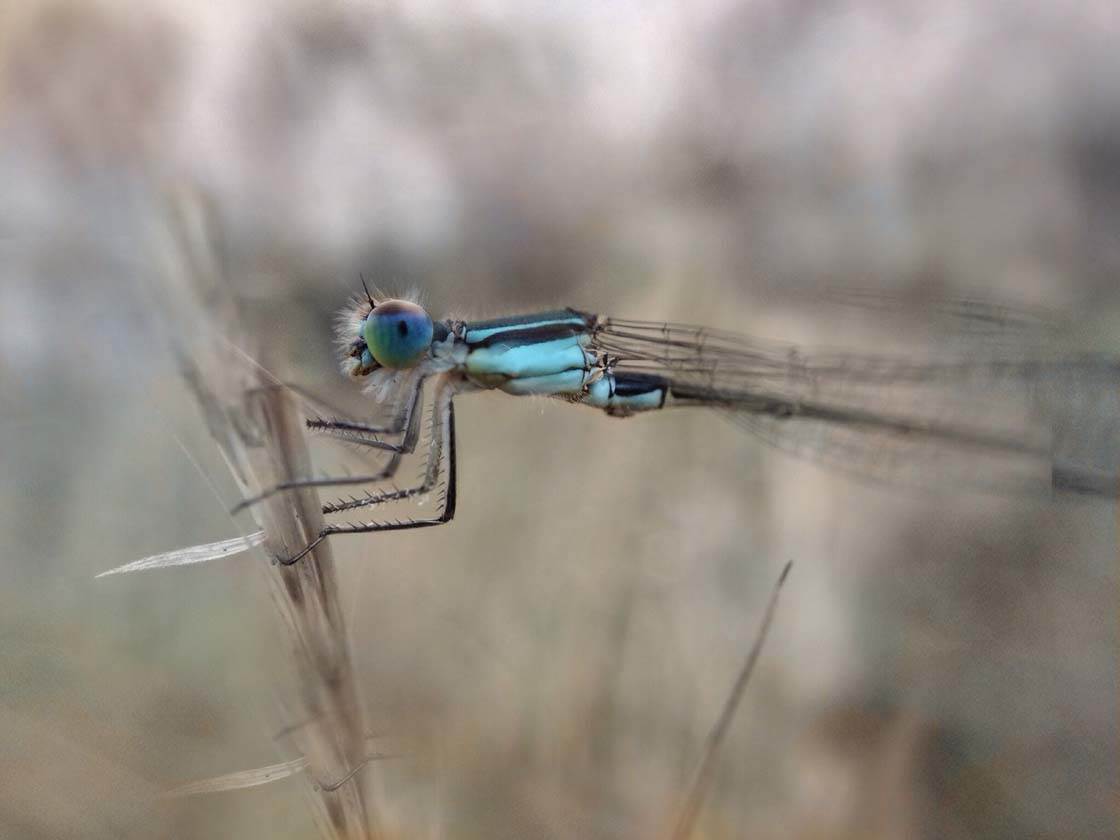
The best places to find bugs are on leaves in trees and shrubs, and also in the grass and on the sand. You can track them through the air until they land on something. You can also find amazing subjects to photograph in tidal pools.
In order to photograph the fast-moving bugs and jumping spiders, there are a few things that really help. Before I even go outside I open up the Camera+ app which I use for taking photos, and separate focus from exposure, setting the focus in the centre. I can later quickly set the exposure just before I take the photo.
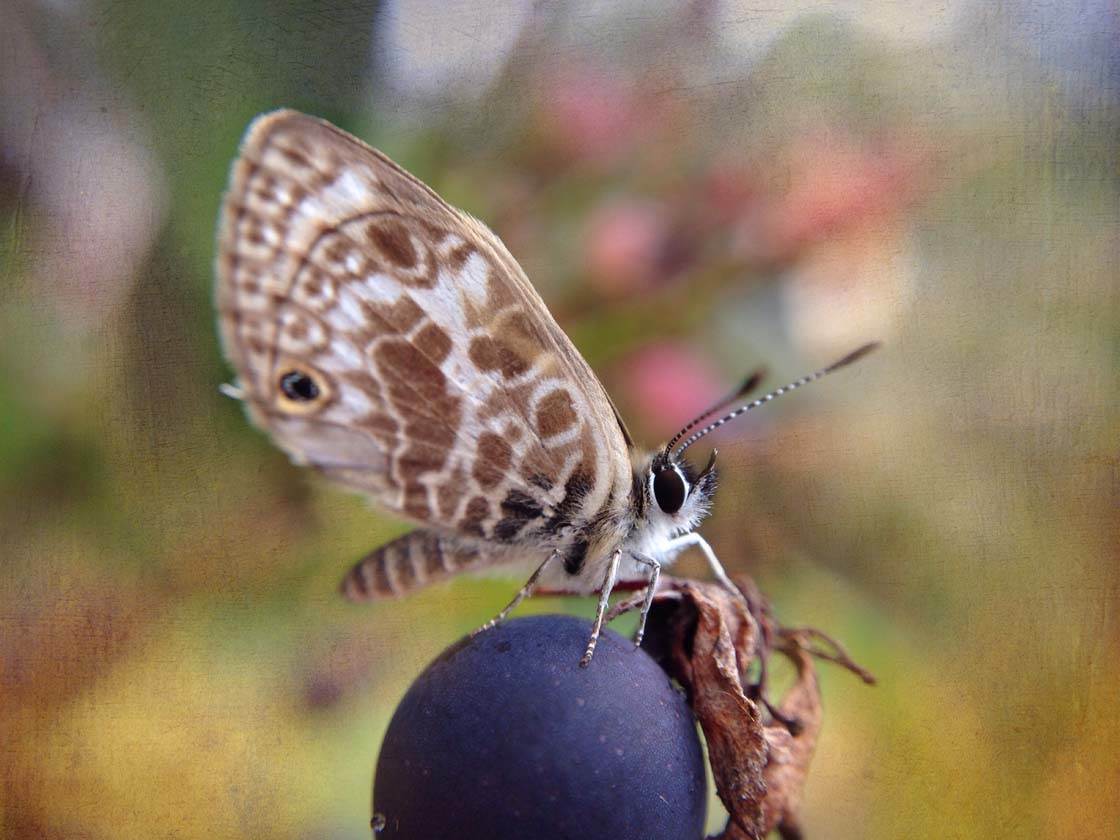
When taking macro photographs of insects, you have to be really stealthy, moving slowly and carefully. I also try to wear well-fitting clothes that won’t flap about in the wind and scare potential subjects, and I tie my hair back.
I take time to study my subject for a little while, to help me anticipate its movements. If the subject remains still, I can hold the leaf or the branch and wedge my iPhone into the same hand which becomes a makeshift tripod. When the moment is right I press the shutter. I usually takes heaps of photos, while trying to stay as steady as possible.
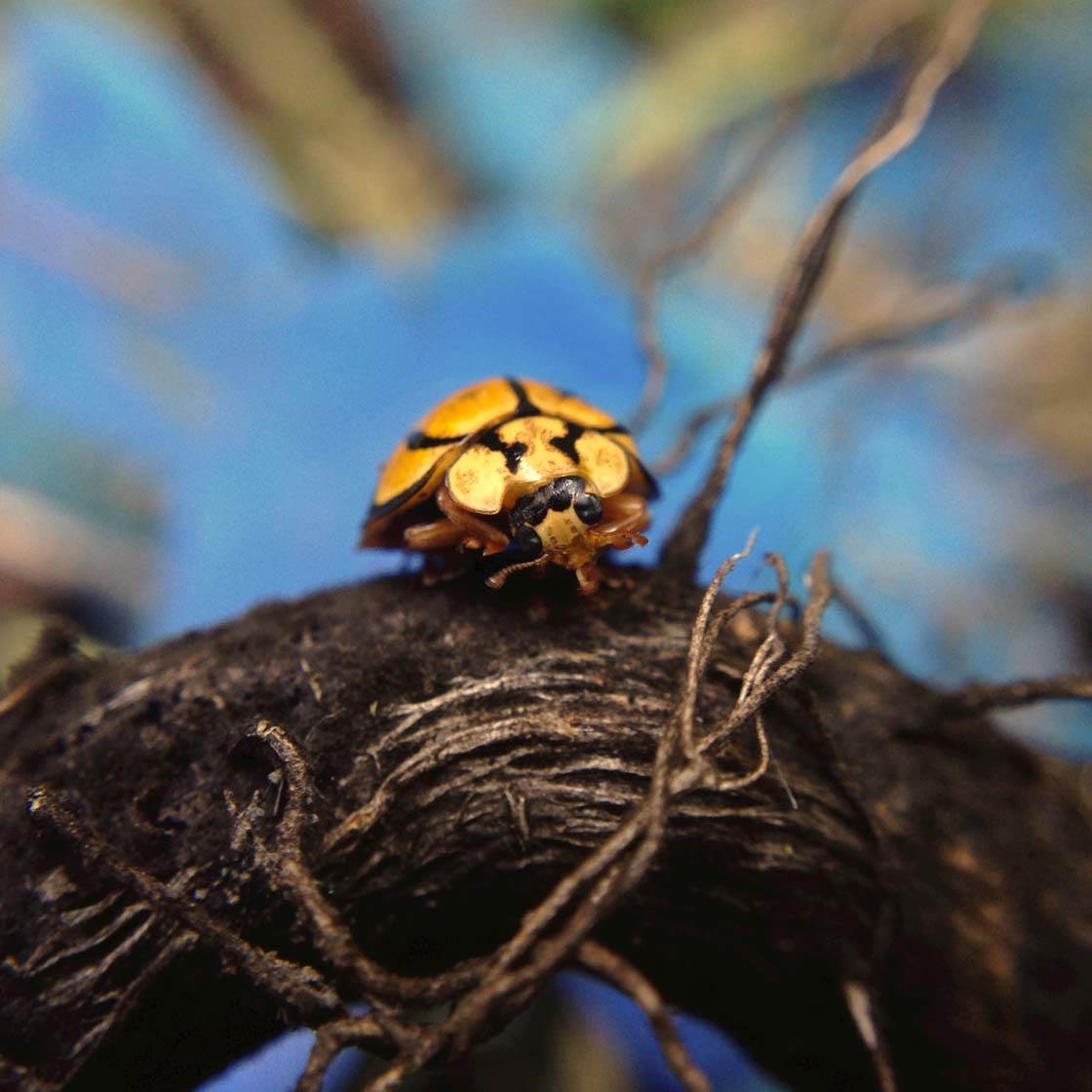
If the subject is moving a lot, I’ll pick up a twig from the ground and encourage him onto it, so I can get more control over where it goes. If I do remove a subject from their habitat, I always try to place them back in the same spot I found them.
The best times for taking iPhone macro photos of insects and moving subjects are early morning, late afternoon, when it’s overcast and just after rain.
Could you tell us about the equipment and iPhone accessories that you need for taking great macro photos?
A good macro lens is essential. I’m currently using the 4 in 1 Olloclip lens system which contains two macro lenses – a x10 and x15. I frequently use both lenses, which are readily interchangeable.
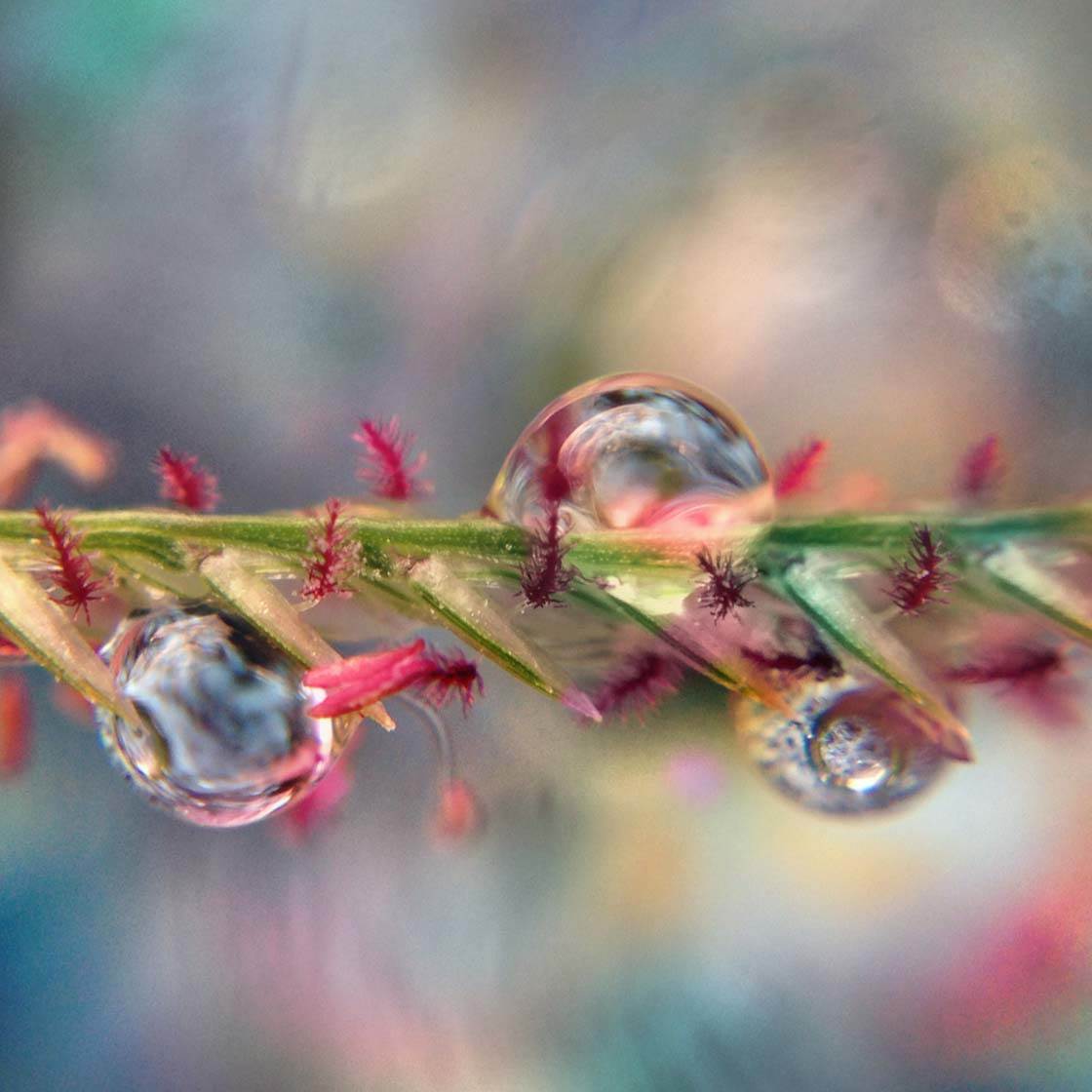
I don’t tend to use a tripod because I need the freedom to move with my subject. A monopod might be helpful, but I’m still thinking about it. A GorillaPod might be something I’d invest in for subjects that are stationary or motionless.
For outdoor photography, I sometimes take props with me to create my own “outdoor set.” I use a blue glass paperweight or piece of blue plastic which doubles as a “sky” for the background, or I might add a colorful pink flower behind my subject.

Inside, I like to use the top of my washing machine as a nice clean white base, with a sheet of white paper in the background. This gives me a fresh clean “indoor set” if I’m photographing shells, feathers, etc. The laundry area has great light which I can filter with a semi-transparent plastic sheet over the windows.
I also use a rechargeable portable charger, called Charge On the Go, for when my iPhone battery runs low while I’m out taking photographs.
Your macro subjects are beautiful in themselves, but you’ve also developed a style of further enhancing your images using textures and painterly effects. What made you decide to start editing in this way?
I think I began enhancing my images with textures and other painterly effects because I wanted to portray my subjects in a more unique way, just as many of my photographer friends with DSLR cameras set up a studio with their models in finest attire and spend a lot of time getting the lighting, ambiance and environment right.
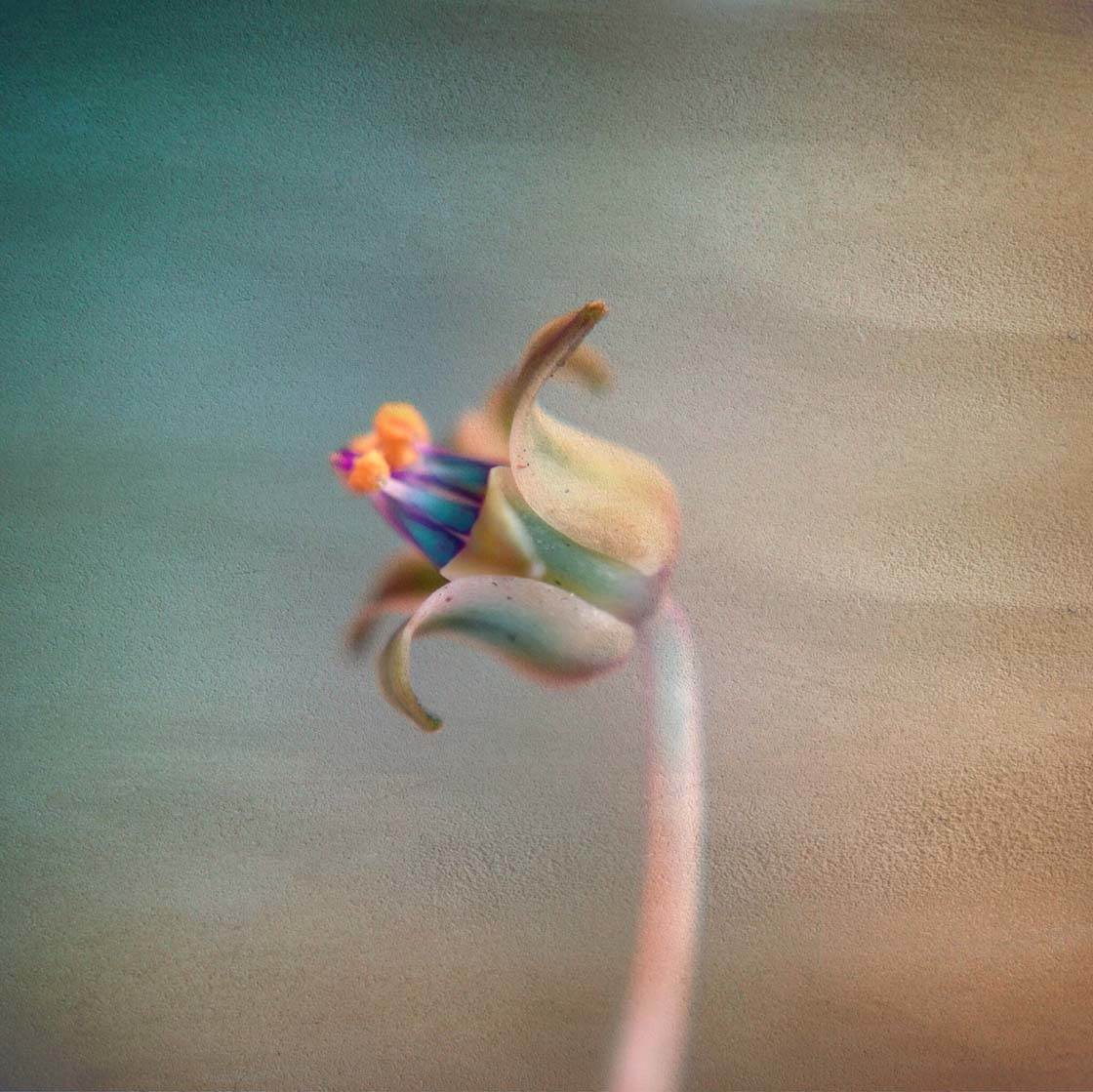
I enjoy styling, and always wanted to be a fashion designer/hair stylist, so this activity of styling and enhancing my subject, hopefully without overdoing it, really appeals to me and felt like the next step.
I develop quite a deep affection for my subjects whilst taking their photographs, so I want to portray them in a way that is fitting and meaningful for me.
As well as taking wonderful iPhone photos, you’re also a talented artist. Do you think this has an effect on how you approach photography?
Thank you so much. I really do think being an artist does have some bearing on my approach to photography. The processes I undertake in my work as a visual artist are mirrored in a lot of ways.
I begin with a subject that charms me, and from there I work towards enhancing that subject and background as much as possible with attention to light, shadow, color and texture to bring out the very best in it. So, whether it’s a drawing, painting, poem, song lyrics, short story or photograph, the creative process is similar.
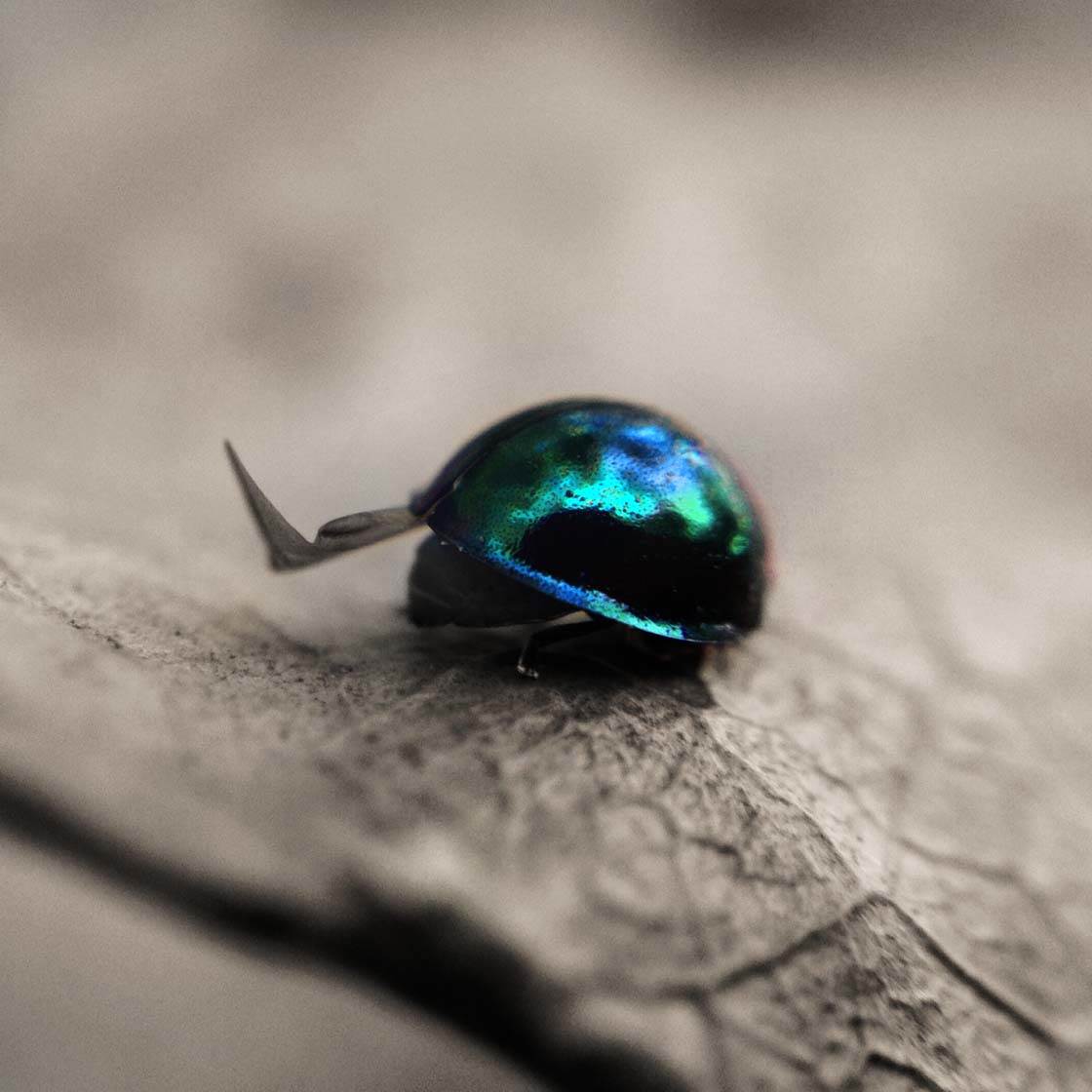
Because I’ve had the experience of practicing art for most of my life, I’ve come to know how it best works for me, and I do think this is an advantage. Particularly advantageous, is not being hard on oneself if creative flow dries up.
There is also some crossover. When I’ve taken an iPhone photo that I particularly love, I sometimes attempt a painting of it. This can be challenging, but it can give you a deeper appreciation for your subject and help you understand it more, which I think results in me taking better photos of those same subjects in the future.
Are there any apps that you use for taking photos besides the native camera app?
My favorite app for taking photos is Camera+. It seems to me to be very intuitive. I don’t use it much for editing, but love it for taking photos because I can preset focus and separate it from exposure.

By setting focus before I go outside, I’m much more prepared for the quick shots I must take in order to capture the fast-moving insects and spiders. This then only leaves me to adjust exposure, which is really easy. I’m constantly adjusting the exposure when taking my iPhone macro photos.
What are your favorite apps for post-processing?
My favorite apps for post-processing in order of preference are: Filterstorm Neue, Filterstorm, Stackables, Snapseed (check out our Snapseed tutorial), Pixelmator for iPad, Rookie, Camera Awesome, iColorama S, Mextures and Procreate for iPad.
I use Filterstorm Neue the most, as it gives me great control over the creative process. I like that I can create effects on certain parts of a photo, for instance, just the background, without losing any quality in the main subject area.
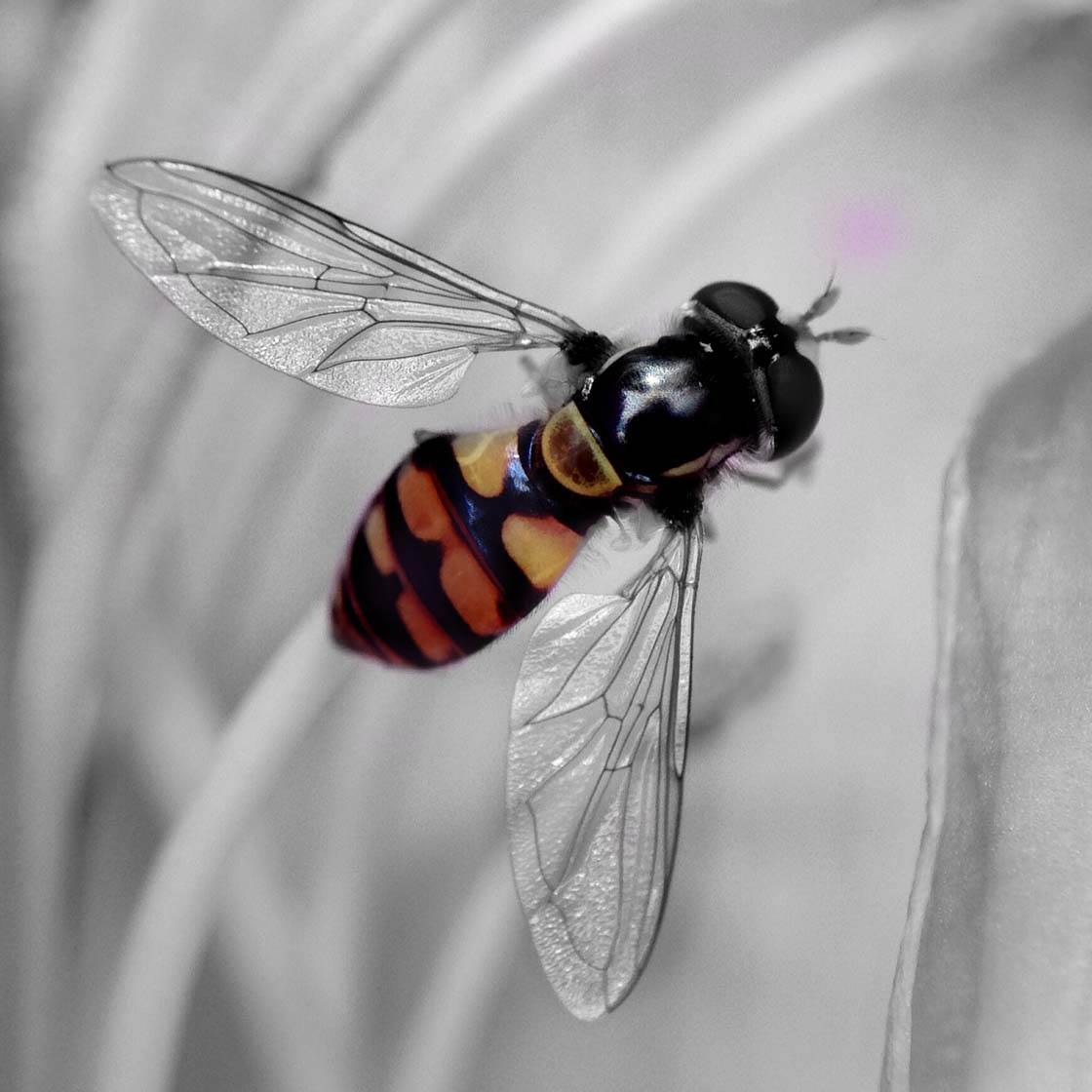
Working in layers allows me much greater control and freedom, without having to change the entire photo with a preset filter. I can obtain the look I want by building up different layered effects and then erasing the parts of a layer I don’t want. This allows the main subject to show through, creating just a background using those effects.
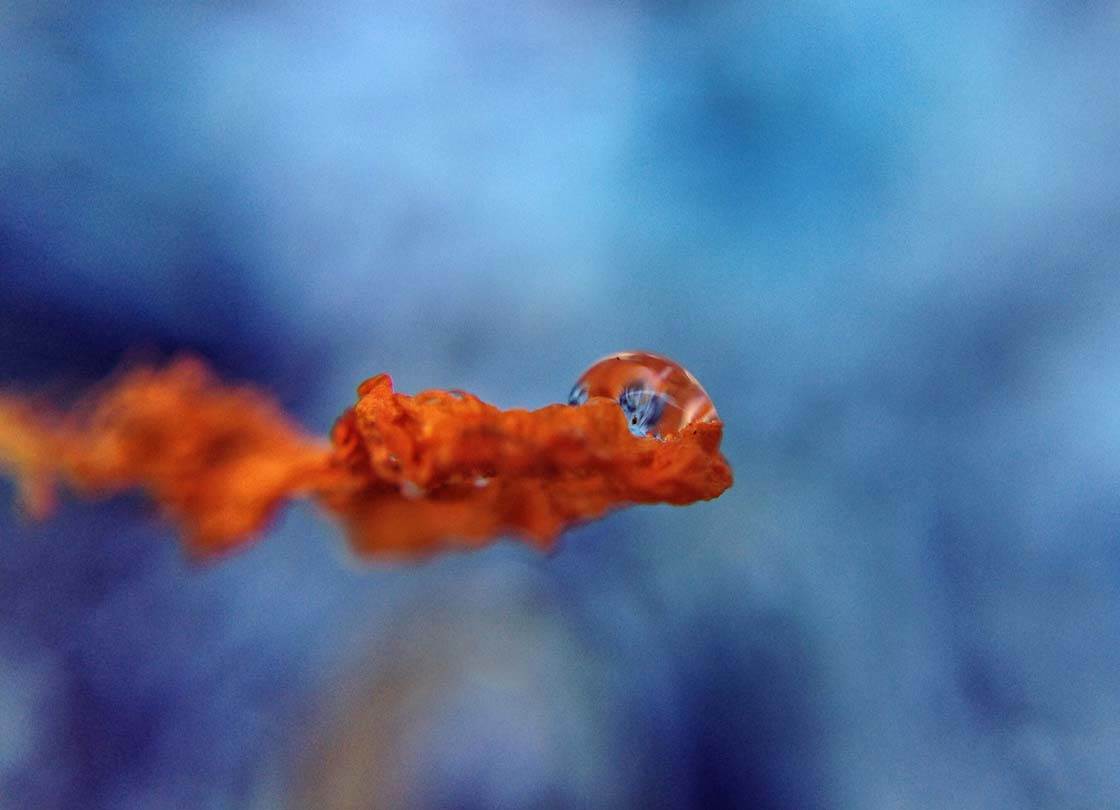
Snapseed is great too because you can select specific areas to edit the brightness, contrast, saturation, etc. If a photo is a little too soft, it does a really great job of sharpening the details with the Details/Structure option.
Can you briefly explain the story and editing process behind your three favorite iPhone photos?
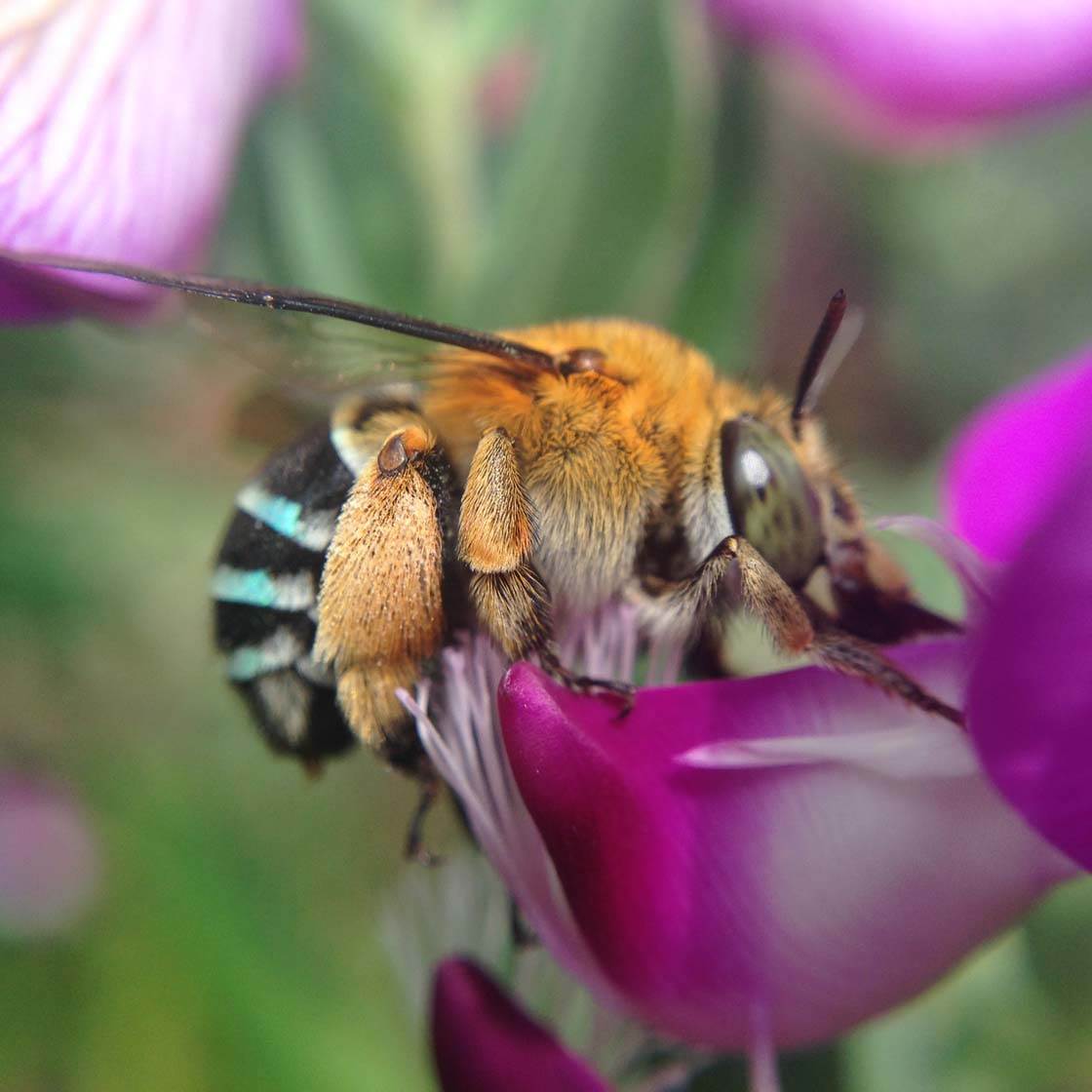
I’ll never forget the day when I first saw these native bees. They buzz more loudly than any other bee and have a large heavy body. I think they’re the most divine creatures.
The way I captured this bee was a bit of a fluke. I was kneeling down low and he landed right in front of me, so I didn’t have to move much at all. I had my camera open, ready and focussed and luckily the exposure was okay as I didn’t have time to reset it.
I just held my breath, hoping not to move, and touched the shutter a number of times to capture as many shots as I could. It wasn’t until I got home that I realized I’d managed to get a fairly clear photo. I was lucky as they’re very shy and difficult to capture.
This photo required very little editing. I cropped it in Snapseed and enhanced the blue stripes by using the Contrast/Brightness/Saturation option.
This photo also won Photo of the Day in my local newspaper. I had a request through the newspaper from an elderly lady for a print of this. She phoned me and told me she had a similar Blue-Banded bee in her own garden. We struck up a friendship and sent each other Christmas cards. I was really touched.
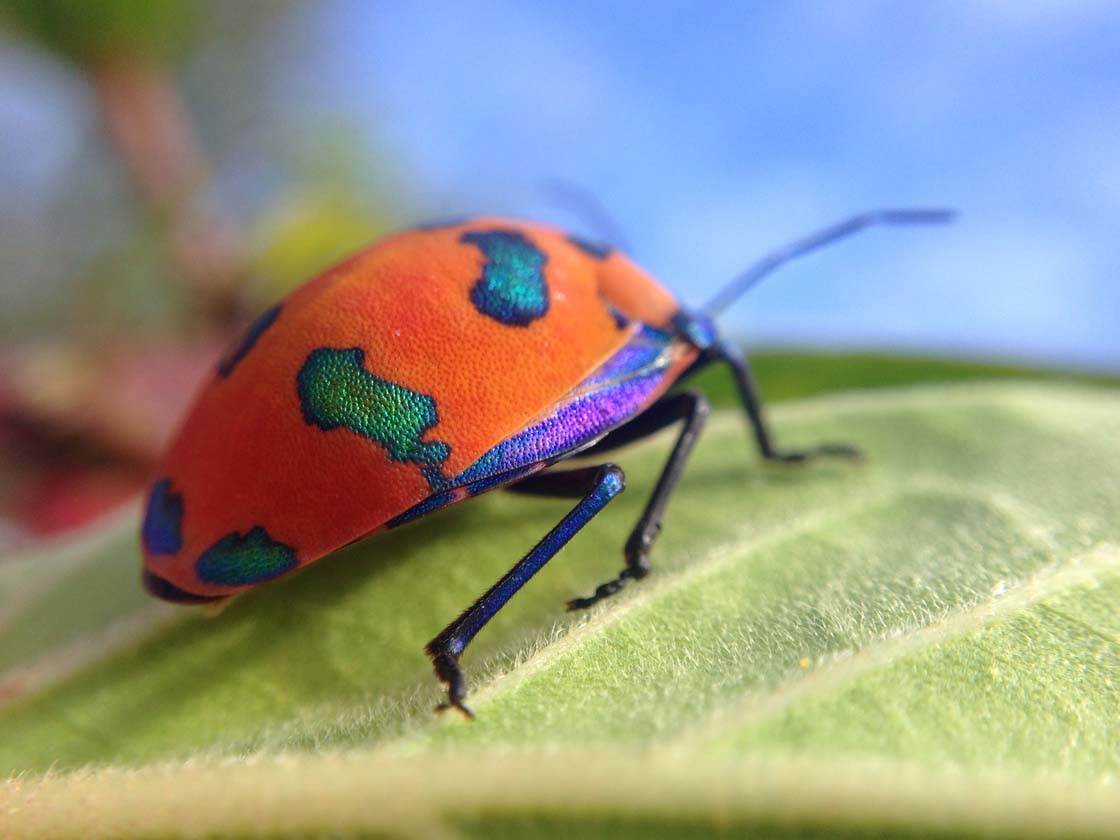
I took this while perched on a stool, leaning over my fence into my neighbor’s yard where they have a lovely hibiscus shrub. The hibiscus is often the host plant to a species of beetle known as the Cotton Harlequin Bug, or sometimes called a Stink Bug here in Australia as they emit a very distasteful smell as a defensive mechanism.
These bugs come in a lot of different colors and sizes, and have beautiful iridescent markings. That day the sun had gone behind a cloud, so even though it was a fine and sunny day, it was less bright and the lighting just perfect.
Like the previous photo, I just happened to be there at the right time. If it was any sunnier or brighter, this capture wouldn’t have turned out nearly as well. This bug was sitting on a leaf and that’s the sky you can see in the background.
I did very minimal editing of this, if any. I think it was basically just cropped and I may have slightly increased brightness and contrast in Snapseed.
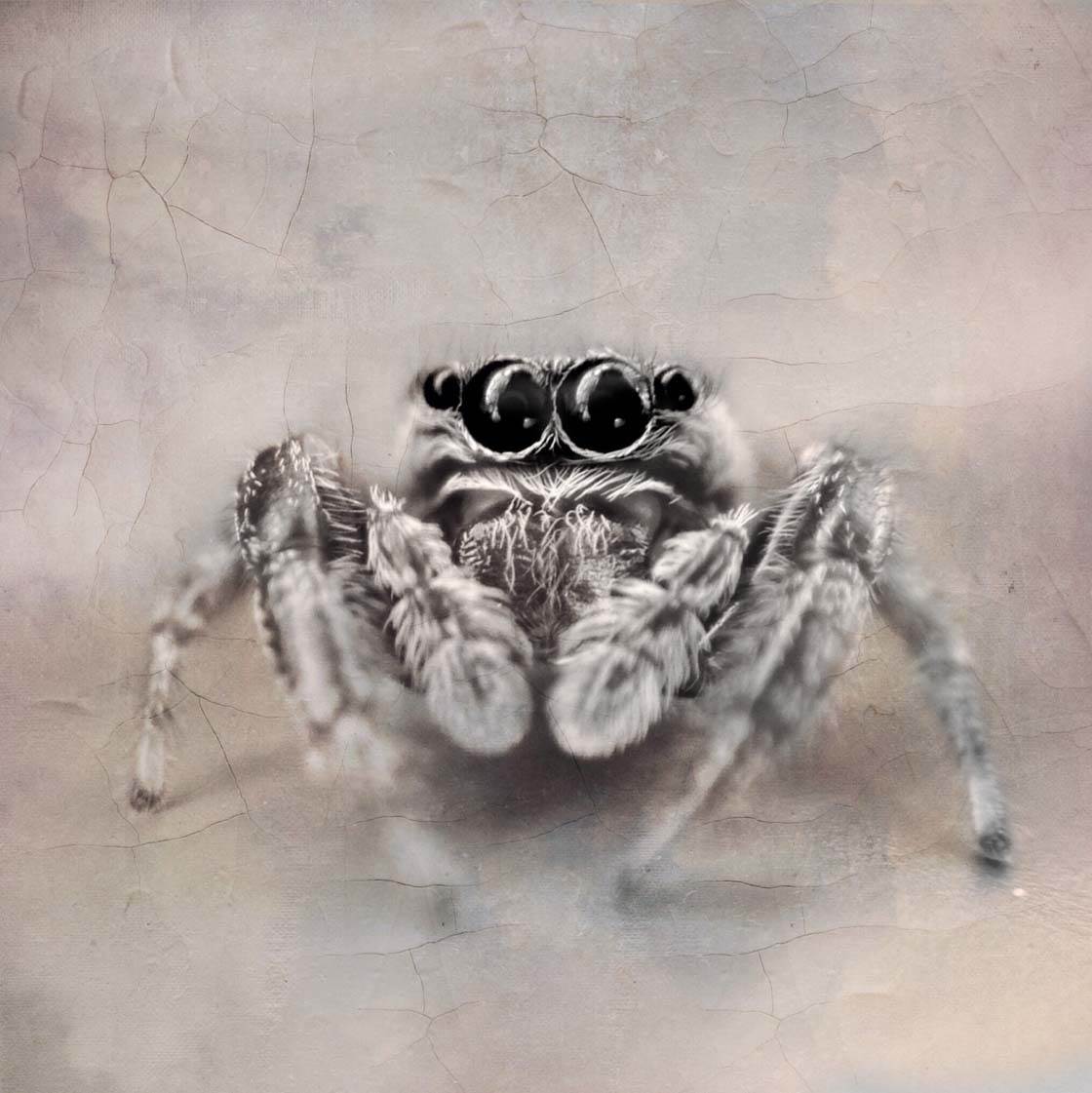
The day I took this photo, it was late afternoon and he was perfectly poised on my back fence. The late afternoon meant I had good filtered light, and thankfully he stayed very still for me. I had to twist myself almost upside down to get the camera lens focussed this close to him and head on, so you could really see his eyes.
I edited the image in Filterstorm Neue by adding a background layer on top from Stackables and deleting some of the layer to allow the spider to show through. It’s really rare to get good photographs of these little guys, so when I do, I feel so happy!
After I took this photo, I became even more enamored with jumping spiders and can’t wait until I meet the next one! This photo won a Photo of the Day award in the local newspaper too.
Apart from macro photography of nature, do you like to photograph any other types of subject with your iPhone?
I also enjoy taking macro photos of still life subjects indoors, such as setting up glycerol drops on objects like the page of a book, or candy like licorice on a rock facing out to sea.
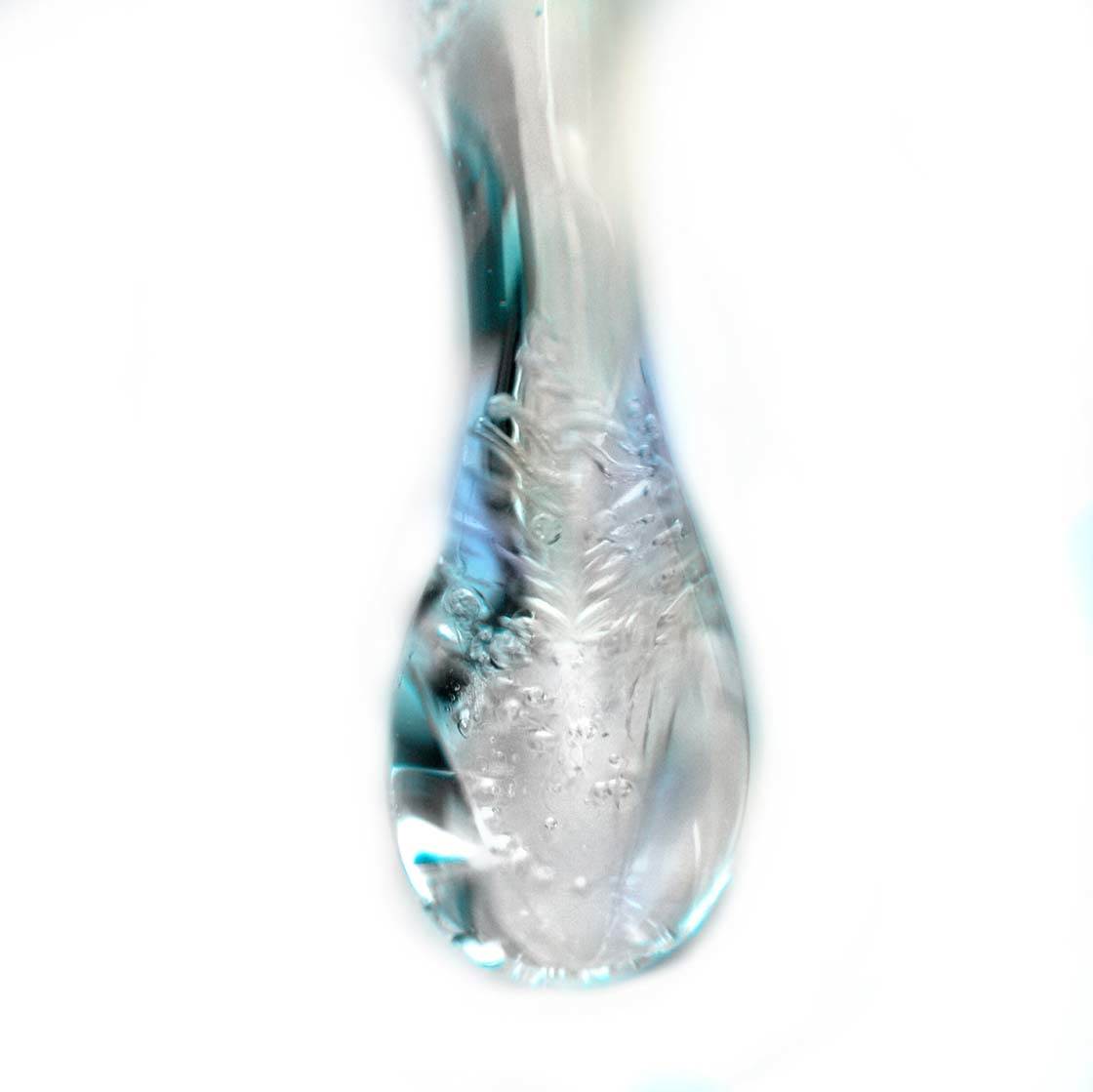
I’ve also started photographing the sea, using an iPhone tripod with Slow Shutter Cam app, to get beautiful foggy or satin-like effects on the water. I’ve taken a few pictures of the freshwater lake when it’s still with sky reflections on the water.
I like photographing unusual trees and playing around with self portraits. Another thing that appeals to me are windows and doorways of old buildings, and objects with peeling paint and rust as I love texture.
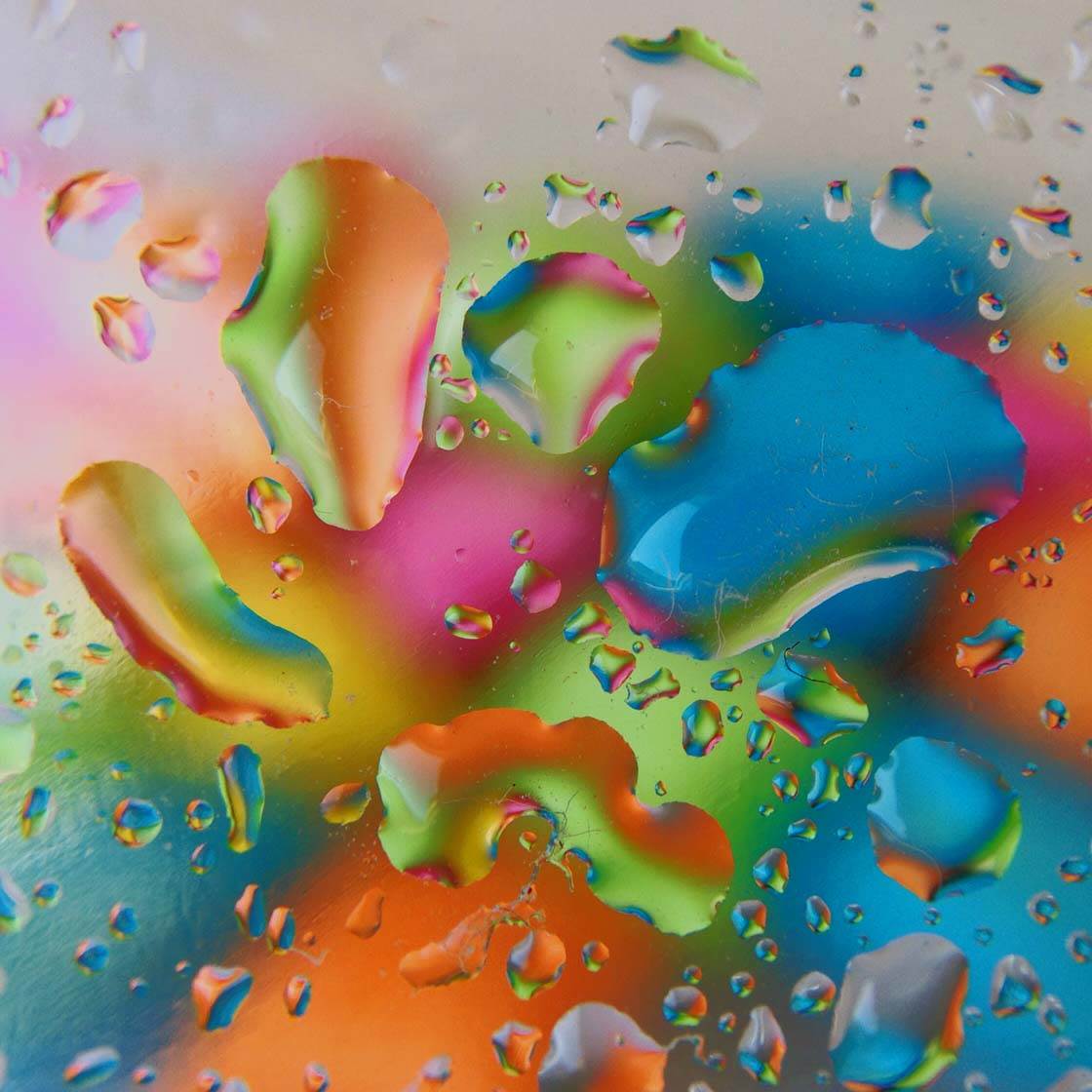
I would like to take more photographs of people and try out some more street photography too, but I’m a bit nervous about that!
What tips do you have for beginner iPhone Photographers who want to start taking more creative photos with their iPhone?
Practice and read, become like a sponge. Open your ears, yours eyes and your heart to learning. Be closed off to nothing, be prepared to listen. Make lots of time for it. Do it for yourself, as a gift to you.
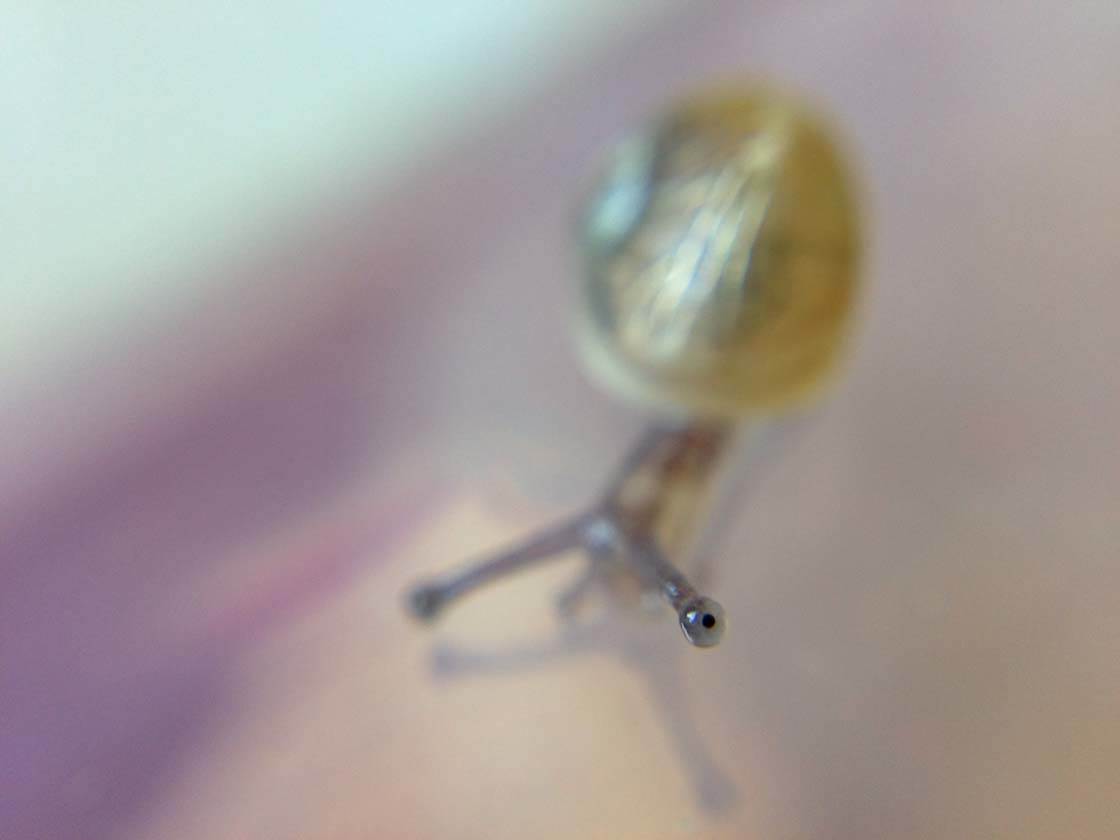
Get as much experience and practice as you can. Make it your priority. Take thousands of photos. Share very few, only your best. Don’t share until you’re ready and confident.
Take Emil’s iPhone Photo Academy course like I did. It was fantastic. It gave me so much help and scope, and a whole new and lovely community of avid and encouraging iPhone photographers to share the journey with, grow with and learn from.
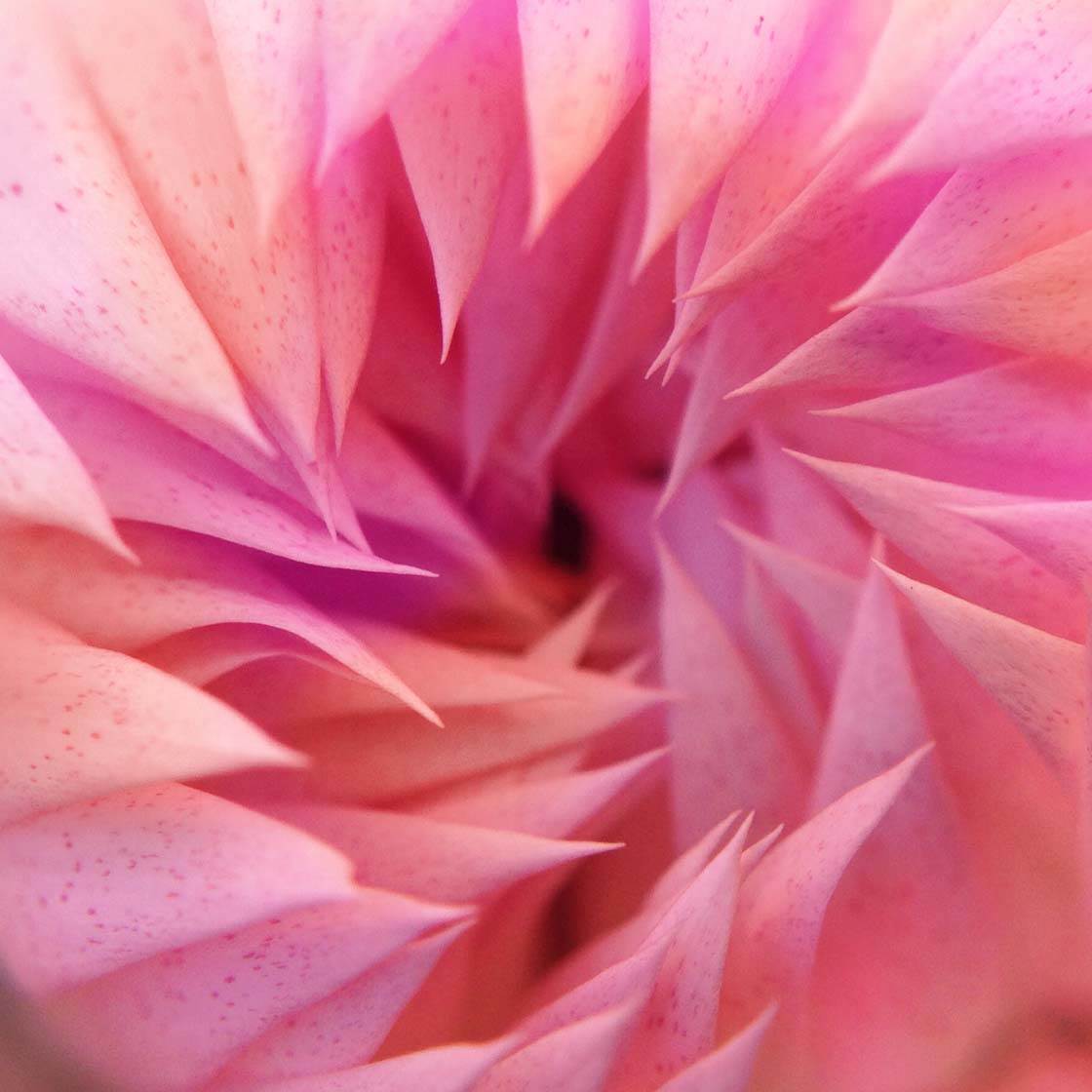
Be willing to try new things. Direct polite questions to those iPhone photographers who you admire – they’re usually only too happy to discuss their process with people who are starting out. Accept help and advice. You never know what you might learn in the process or who you might meet.
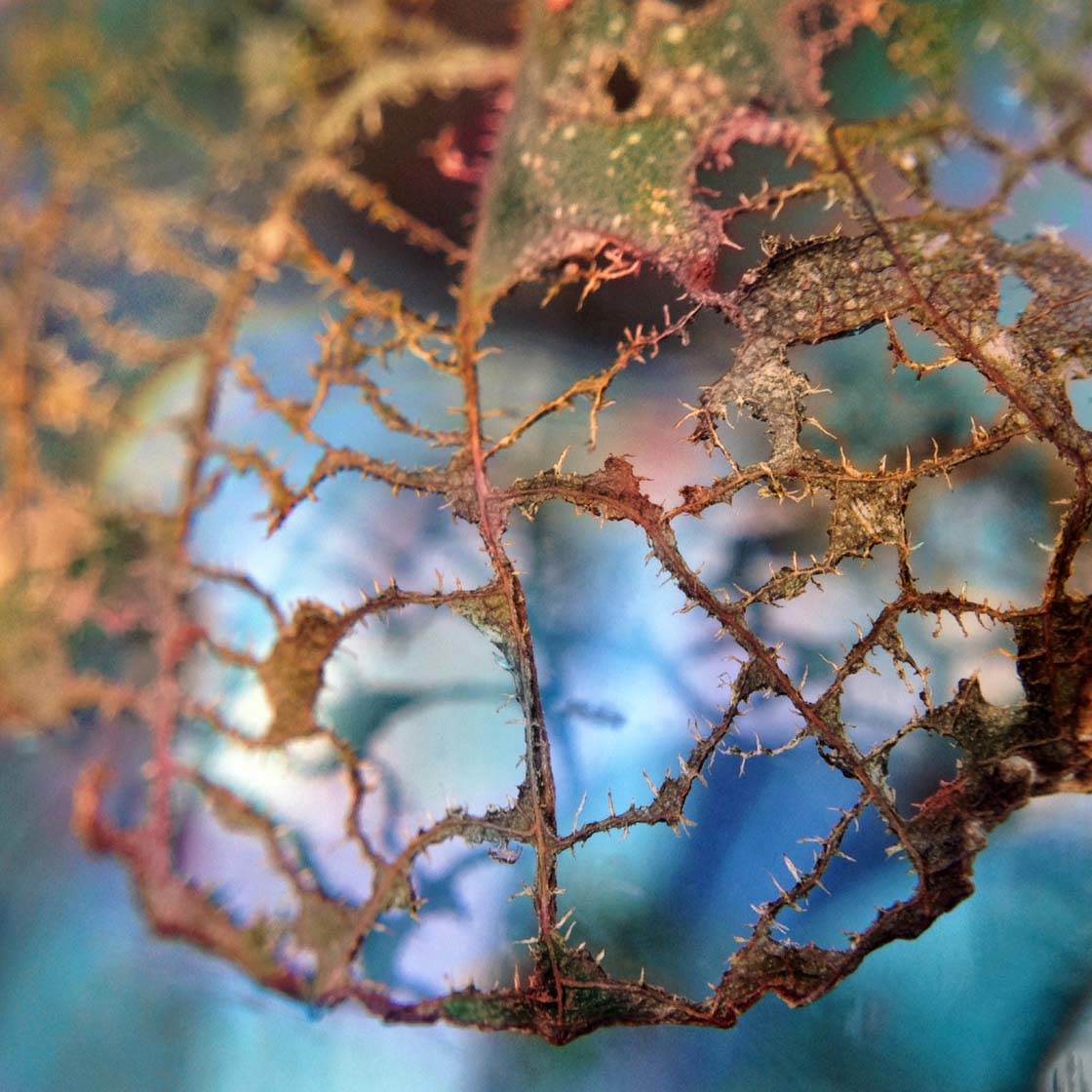
Be “photo opportunity ready” by having your iPhone charged at all times. Take it with you everywhere. Start saving towards accessories you’d like to acquire and improvise as much as you can initially with what you already have lying around.
Get to know yourself and your creative process. Don’t feel bad about taking time out to pursue your photography. Creativity is an important aspect of everyone’s life, and too few people take the journey.
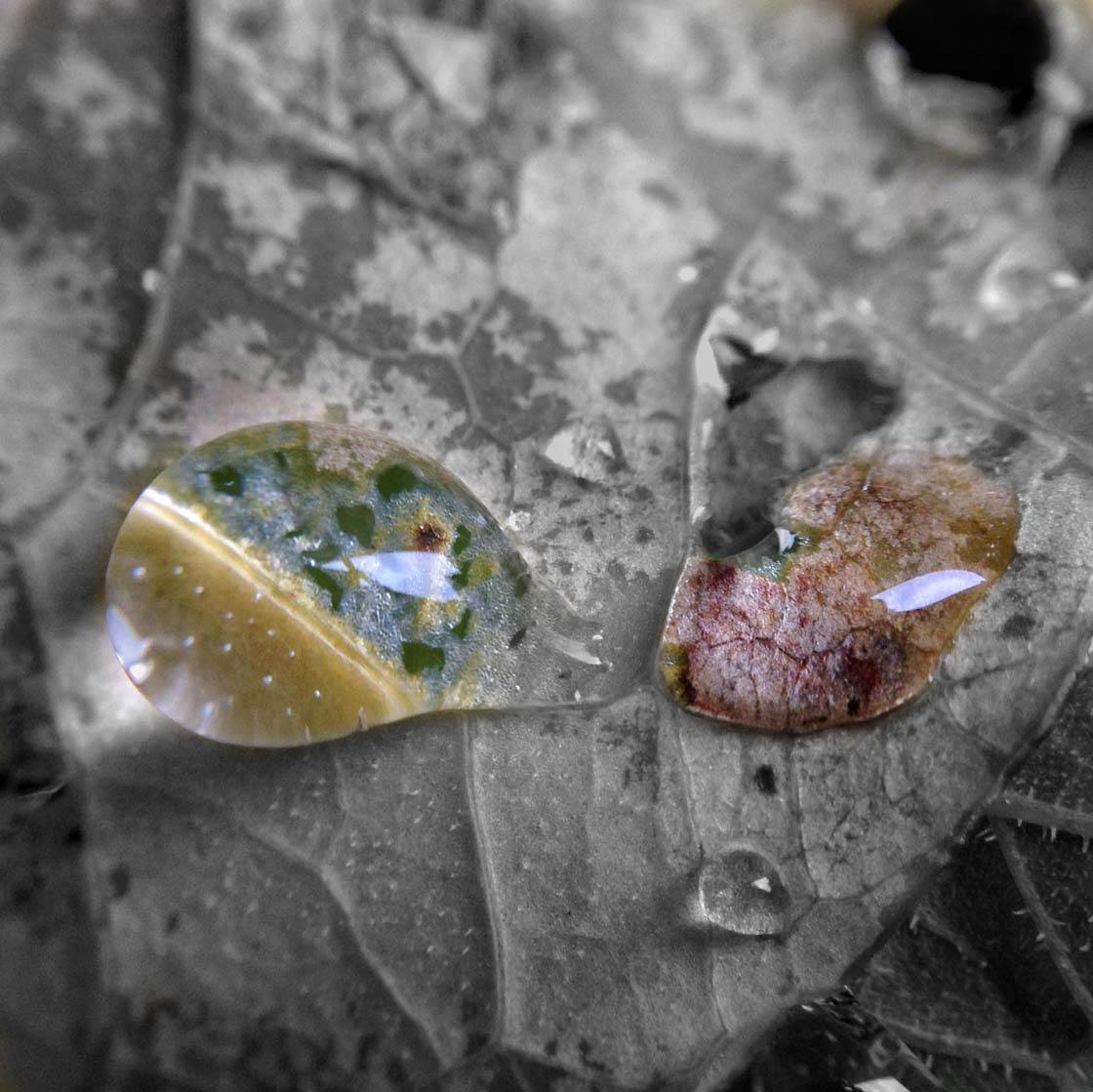
Try not to get frustrated. Don’t worry if you don’t feel like taking photographs for a while, it’s part of the normal creative ebb we experience after creative flow. Take photos of things you love, are fascinated by, have a special affinity with or that you want to learn more about.
What’s next for you in your photography journey?
My next ambition is to purchase a new iPhone with a lot more space. I’m really hoping that the next generation iPhone will have a much improved camera so that larger prints will be possible. I also hope to save up for my first DSLR with macro lens, so that I can get more magnification of my subjects.
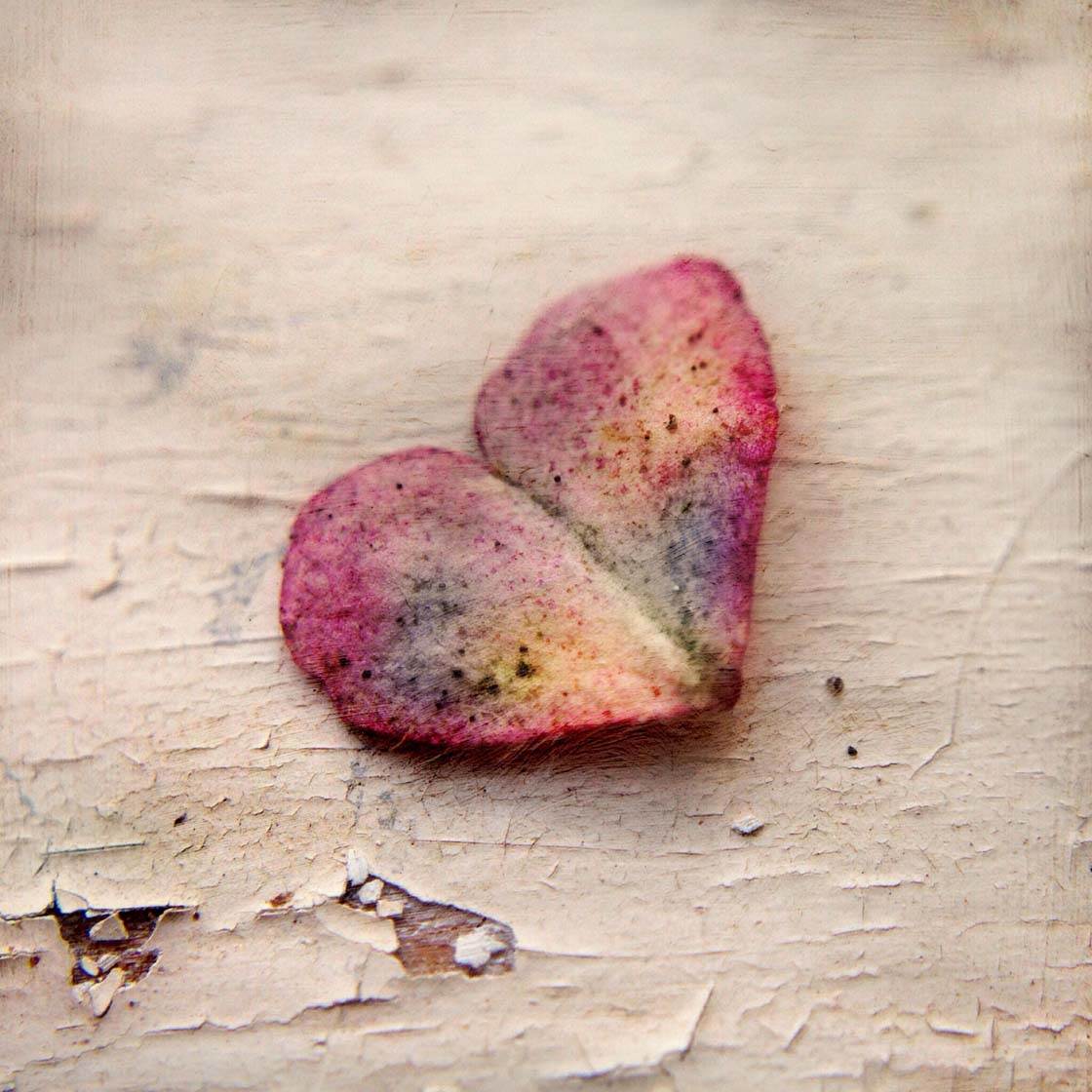
I will always use my iPhone for macro photography of fast moving insects because a larger DSLR won’t give me the freedom and portability I need to follow them around.
Which iPhone photographers do you admire the most?
There are so many I admire, but to name just a few: Emil Pakarklis @iPhone_Photography_School – Emil is the founder of iPhone Photography School and I love his photos of reflections and ice, they’re so pure.
Erika C. Brothers @ecbrothers – her underwater and creative painterly photos are astoundingly beautiful (check out our interview with Erika).
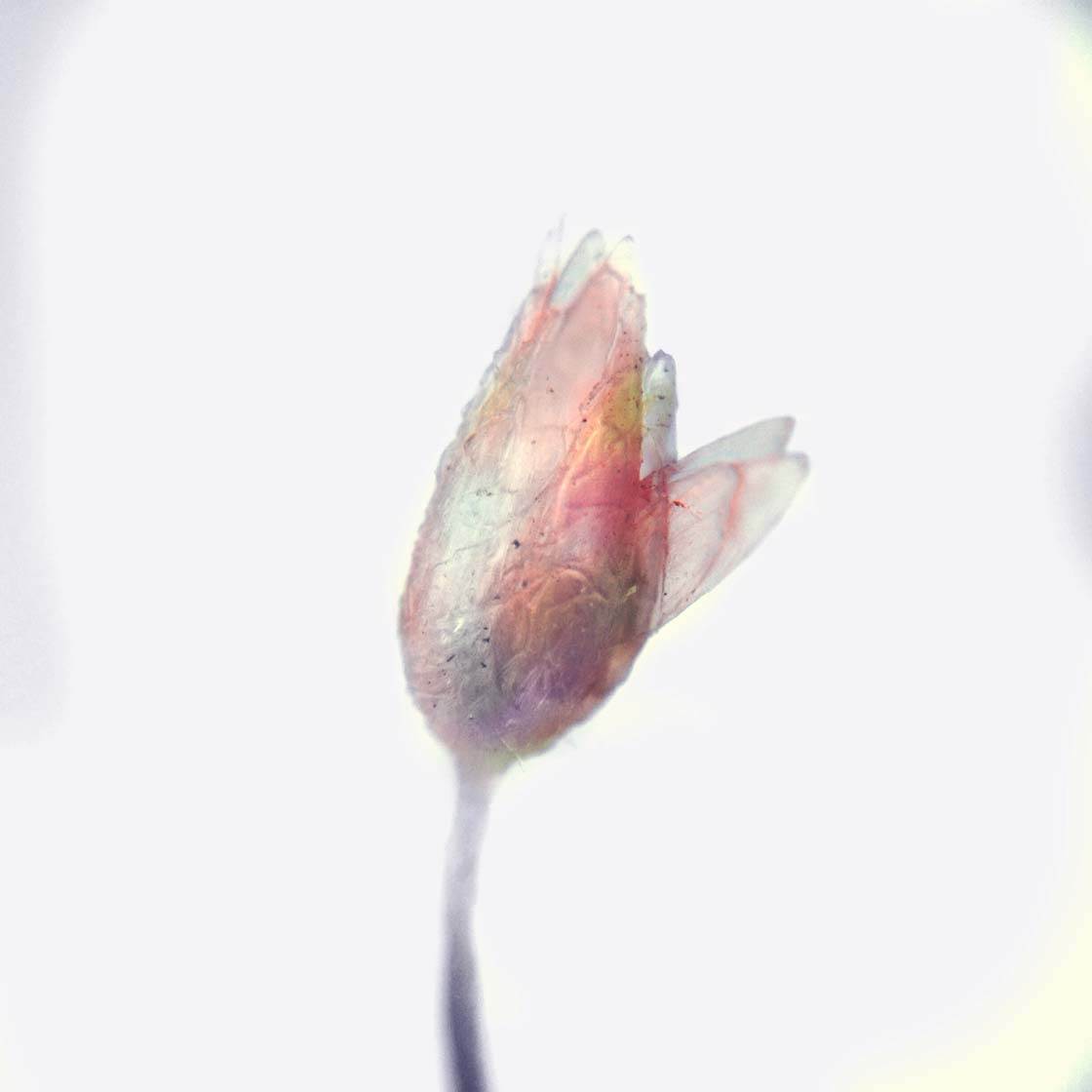
I also love the work of Paul ‘Skip’ Brown @skipology – he works predominantly with black and white and takes emotive portraits that include his family and pets (read our interview with Paul).
Rob DePaolo @rdepaolo takes creative black and white self portraits that are stunning (check out our interview with Rob)!
I also love the surf and lifestyle iPhone photography by Chris Burkard @chrisburkard.
Where can we see your iPhone photography?
You can see my work on Instagram @karinlouisetaylor, EyeEm @karinlouisetaylor, Tumblr @karintaylorphotography and Facebook @karintaylor.online. I also have a blog, and you can order prints of my photos and artwork on my RedBubble page.
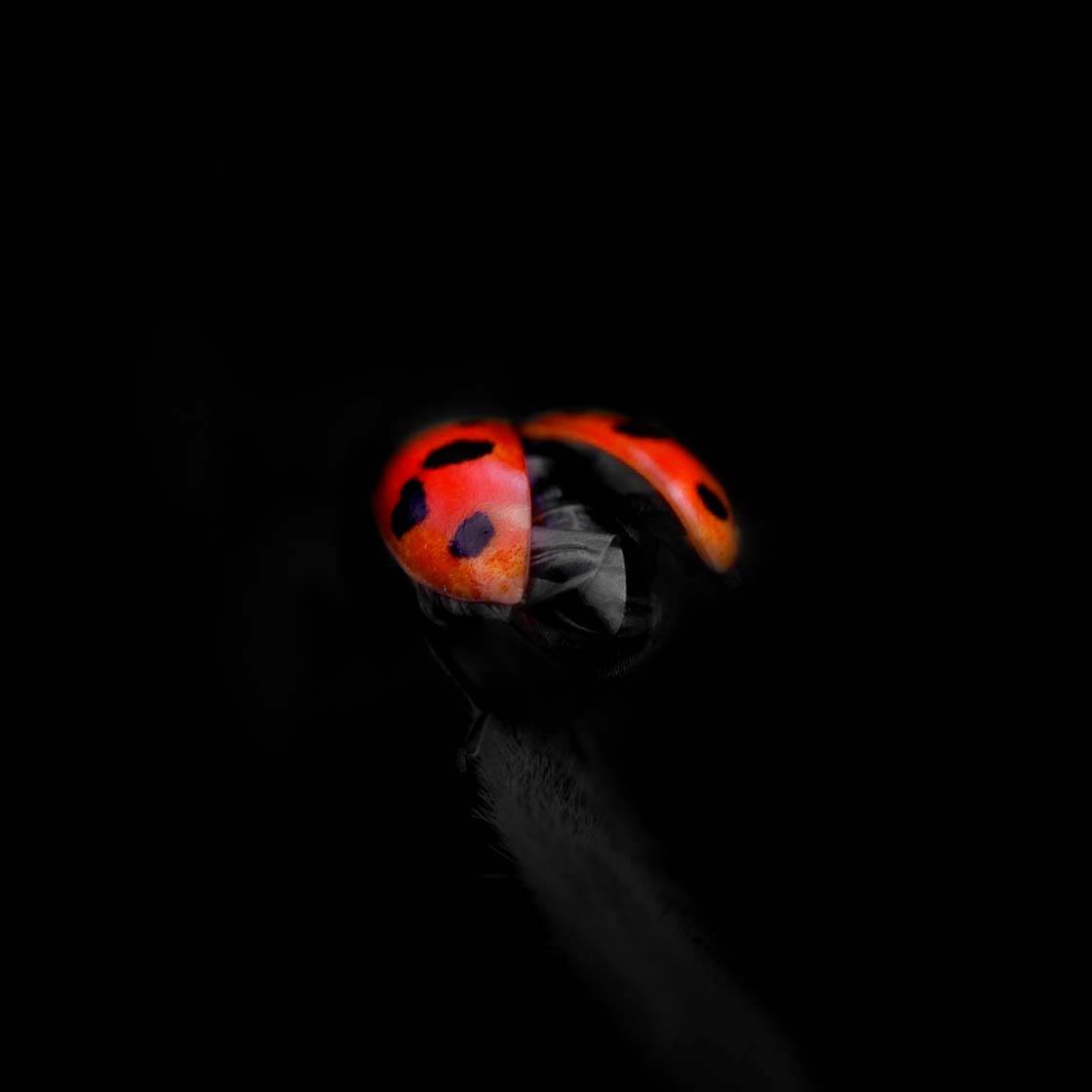


Great tips, thank you sou much Karin! I love macro photography, but I’m an absolute beginner… Love your insects including the spiders…
An editorial about Filterstorm Neue would be great… @iphoneps
Thanks so much, so glad you enjoyed it!
Thank you, Karin, for taking the time to share your knowledge of macro iPhone photography with us. Your photos are absolutely stunning! 🙂
Thanks so very much Kate, my pleasure and a great honour!
Amazing work Karin. I have tried Macro photography in the past but was never very good at it. This article has inspired me to try it again 🙂
Hi Paul, thank you so very much, I’m so glad this article has inspired you to try out Macro Photography again! I’d really encourage you to keep on practising and don’t give up, it’s not always easy, and I get discouraged sometimes, but it’s really a worthwhile pursuit. There are lots of macro photos I take that I do delete and never show anyone because they haven’t been good enough. I try not to let myself become too discouraged when they don’t work out, there is always another photo opportunity just around the corner! With practise, you will get better and better and the results will be rewarding and even pleasantly surprising sometimes. It’s definitely worth it to keep on trying! Sometimes, I am just about to give up because I won’t have seen anything, or the photographs I’ve taken weren’t up to scratch, then I’ll see something like the other day, that just blows my mind (two hoverflies mating!) and I realise that it’s more about being ‘photo opportunity ready’ than anything else. It’s important to have the right equipment, etc. but equally important to be extremely conscious of the tiny worlds that surround us. 🙂
Hi Karin – I posted this comment in the iphone photography school macro lesson in week 4 – where you made offered some wonderful insights into your macro work – not sure if you saw it so thought I would repeat some of it here …
I am just a baby beginner
but am absolutely drawn to macro, for many of those reasons that you
articulate so beautifully here. Your work is so very inspiring and I
try to look at some of your pictures every day because not only does it serve to inspire
me in my own photography journey, but it also teaches me about presence
and gratitude. For just a few minutes I am in awe of the magic you are
able to see and share with the world. 🙂
Hi Michelle, thank you so much for your lovely response! I am so happy to hear that you are a lover of Macro Photography too! It warms my heart that you find my work inspiring and that you get a sense of presence and gratitude, because that is what fuels my desire to keep going on this journey. Discovery is nothing new to humankind, and yet it is always new. We are modern day explorers, still uncovering unseen worlds that are rare and beautiful. I think the joy goes out of life sometimes, when we as adults believe we’ve seen and done everything there is to see and know. Macro Photography gives my life an injection of excitement every single day, because I know that I am going to see things that perhaps not even David Attenborough or National Geographic have not yet documented! Who knows what the journey of discovery will uncover and what new things we will learn. I think that is why I will never lose my love and excitement for Macro Photography. I hope the same goes for you too! I feel like a beginner myself, there is still so much to learn and always will be, and I think that’s a great attitude to have! 🙂
Karin, your photos are REMARKABLE and should be in a book! Have you explored the possibility? Just gorgeous, inspiring work.
I enjoy using my iPhone so much, never would have imagined how much potential it has. And how much easier it is that clunky equipment.
Could you tell us what macro equipment you use and if the camera must be out of the case? I have been looking around for a lens that won’t damage the phone. Any pointers, please, karin. thanks so much.
Sue
Hi Sue, wow, thank you so much for your wonderful encouragement. I have thought briefly about creating a little book/s of my macro photographs, it is something I would like to do!
The iPhone certainly is fantastic for allowing you to get into tight spaces and capture images that would perhaps not be possible with a larger or bulkier DSLR. I see the iPhone as an extension of myself, and it really does feel that way, very organic and intuitive.
I have only ever used the 4 in 1 Olloclip system for iPhone 5. I mainly use the interchangeable lenses x10 and x15. The Olloclip Macro lens fits over the lens of the iPhone snugly, as long as there is no case. To date, I haven’t found a case that would allow me to protect the iPhone while taking macro photos with the Olloclip (there might be something available now, but I haven’t come across it yet). What I would really love, is a waterproof case that allowed me to take macro photographs under water. I do have to take risks with my iPhone in order to capture some of the images I’ve taken. In particular, anything taken above or near water is definitely increasing the risk. I often take macro photographs from just above the surface of the water of rockpools to capture shellfish and sea stars. I do have protective cases, but so far nothing has emerged on the market (that I’ve found so far) that would allow me to protect the iPhone whilst taking macro photos. The Olloclip macro lenses I use are designed to slip over the camera lens and every case I’ve had makes that impossible to do.
As far as any other equipment goes, that is really the extent of it. I have used a tripod in other genres of photography, but not with macro photography, as I have found I need to be able to move around with my subject as they move, as you have to be quite close to your subject to get it in focus (about 2cm).
I do use some props though, and I’ve found that can work really well. I often take a blue glass paperweight with me on my excursions, because it simulates sky/water so well in the background. I sometimes use a rusty stool my father in law made a long time ago, which serves a dual purpose. One it elevates me to higher places in a tree or over the neighbour’s fence and two, it is a nice surface to place subjects, as it creates a textural foreground or background for them. I like to use glycerol as a water replacement when water drops or rain are scarce, and I look for other objects (still life) to photograph constantly. From yarn, to twigs, to tiny spots of rust or splotches. Everything is worth a look under the macro lens, just to check whether it’s photo worthy! Never stop exploring is my motto!
Thanks, for the reply, Karin, and for all that great info. I have come so close to purchasing the lenses over the last few years. I have put it off and just used the phone camera as close as I could get–it’s even amazing how nicely it does when you don’t even have the macro lens! but I am more and more tempted to get the “real thing.” I am still wondering if there is a way to rig the clip with some kind of thin protective barrier so as not to mar the case. I’m beginning to think I should have kept my iPhone 5!
Anyway, I’ll swell your head again: your eye is marvelous, you are a true artiste!
Hugs,
Sue
Thanks again Sue! Im just wondering which iPhone you are currently using and what case you have on it?
Hi, Karin! I am using the 6 and have something called “slim case” as well as another with a built in charger, also very thin. I suspect the case olio lip has for the other models will eventually be available for the 6.
Sue
Hi Sue, I just wanted to give you some great news!!!! Apparently Olloclip are releasing a new protective case for the iPhone 6 and iPhone 6 Plus in March this year, so you will be able to protect the iPhone while using the Olloclip lenses. (4 in 1 Olloclip system).
The 3 in 1 Macro lense for the iPhone 6 is available now!!! Check it out:
http://www.olloclip.com
Fantastic news!!!! Thank you so much for sharing! 🙂
Just checked out the lenses and I see there are “cases” available for every model EXCEPT the 6. Well, I guess it is coming eventually and they finally recognized the need!
Yes, good news, the new Olloclip protective case for the iPhone 6 and iPhone 6 Plus will be available from March this year.
Thanks Karin for the amazing interview – and for your kind words!
U r gay
Thank you so much Emil, it was such a pleasure and really enjoyable process and I’m so grateful for the opportunity! Kate is a great asset to your team and made this a breeze! I am a great admirer of your photography and work ethic. The help you provide here at iPhone Photography School and elsewhere on social media, is without doubt, one of the greatest resources available for iPhone enthusiasts everywhere. Keep up the great work and thank you again for giving me such a great opportunity and showcasing my work!
Superb interview Karin! Your talent, generosity shines through everything you do. You continue to inspire me not only w your amazing photography, but w your poems, musings, drawings n paintings. Thank you for sharing your work and yourself.
Remarkable photos!! Thank you for sharing them and for the and for all the info
Thank you so much Mary, I’m really glad you enjoyed the interview and the photos! 🙂
Hello Karin. These are some of the best iPhone macro shots I have seen! I also take macro photos with my iPhone using a DIY macro lens. I would really appreciate it if you could provide some feedback on a few of my shots and maybe help me progress further? Should I post them in a comment or a website link will be better?
I hope I didn’t offend you by asking this.
Hi RJ, thank you so much! I’m glad you like my iPhone Macro Photos! I’m so interested to learn how you created a DIY macro lens. Can you share how you did so? I would be happy to check out your photography if you are able to send me your website link to karinlouisetaylor@gmail.com 🙂
The lens I created isn’t anything special. I had a toy camera that was in perfect working condition. I opened it up and removed its lens. Then I removed a silver cover from a Kingston data travel dt 101 G2 thumb drive (there are only two kinds of Kingston flash drives that have this cover) , taped the lens to the cover, being careful not cover the center of the lens. The casing is tight enough to fit snugly on your iPhone’s camera, although I would advise that you tape the inside of the cover to prevent any damage to the phone. The best part is that it works well even if you use a thin protective case with your phone 🙂
if you have any problems with the instruction’s, I’ll find the link to the video that I followed.
Wow RJ, that’s amazing! Thank you so much for your generosity in sharing about your DIY macro lens. I had a look at your macro iPhone photos, one of the yellow marigold and another of an ant, I have to say, I was incredibly impressed, what you do with that lens is fantastic! It works beautifully, but it’s your steady hand and concentration and obvious dedication that reward you with such great results! You are so innovative and clever to have thought of this, I take my hat off to you RJ! 🙂
Thank you for your kind words Karin! I hope you keep enjoying my work!
You’re truly a great macro photographer Karin. I always love your photos and your passion of it.
Hi Danny, Thank you so much, you have always been so supportive and I really appreciate it, love your iPhone photography, style and passion for it too!
Thank you so much for that interesting information and the links Sue, I’m looking forward to checking them out! Much appreciated!!!
G’day Karin – that was good read and has given me a greater insight in to your deadly fotos – thanks for taking the time to share……
Glad to hear you enjoyed the interview. Karyn’s photos are stunning aren’t they! 🙂
Thank you so much Troppo Bob for stopping by to read the interview! So glad you enjoyed it! Hope you’re having a fantastic magical time o/s!
Moment Macro Lens: http://momentlens.co/macro-lens/?utm_source=Moment+Macro+Lens+Updates&utm_campaign=f8f0378b20-macro_update_3&utm_medium=email&utm_term=0_0df3fee06d-f8f0378b20-330674081&mc_cid=f8f0378b20&mc_eid=2f029f6af6
Stunning images. I enjoyed reading this.
Thanks so much Elaine! So glad you enjoyed!
I have never viewed such astonishingly beautiful photos of insects or small creatures and flowers as those shown on this post. Thank you Karin Taylor. I am an amateur painter and I’d very much like to use some of your shots to paint. It would take me forever to first learn how to use my Iphone 7 to take anywhere close to what you have achieved in Iphone photography but I am raring to put on canvas a few of your photos. May I, with your permission? Thank you. C. Llamas
Although this was posted many years ago, most of the interview content is still valuable. Thank you, Kate and Karin for sharing this.
Loved hearing about Karin’s passions and her process. Her photos are stunning!